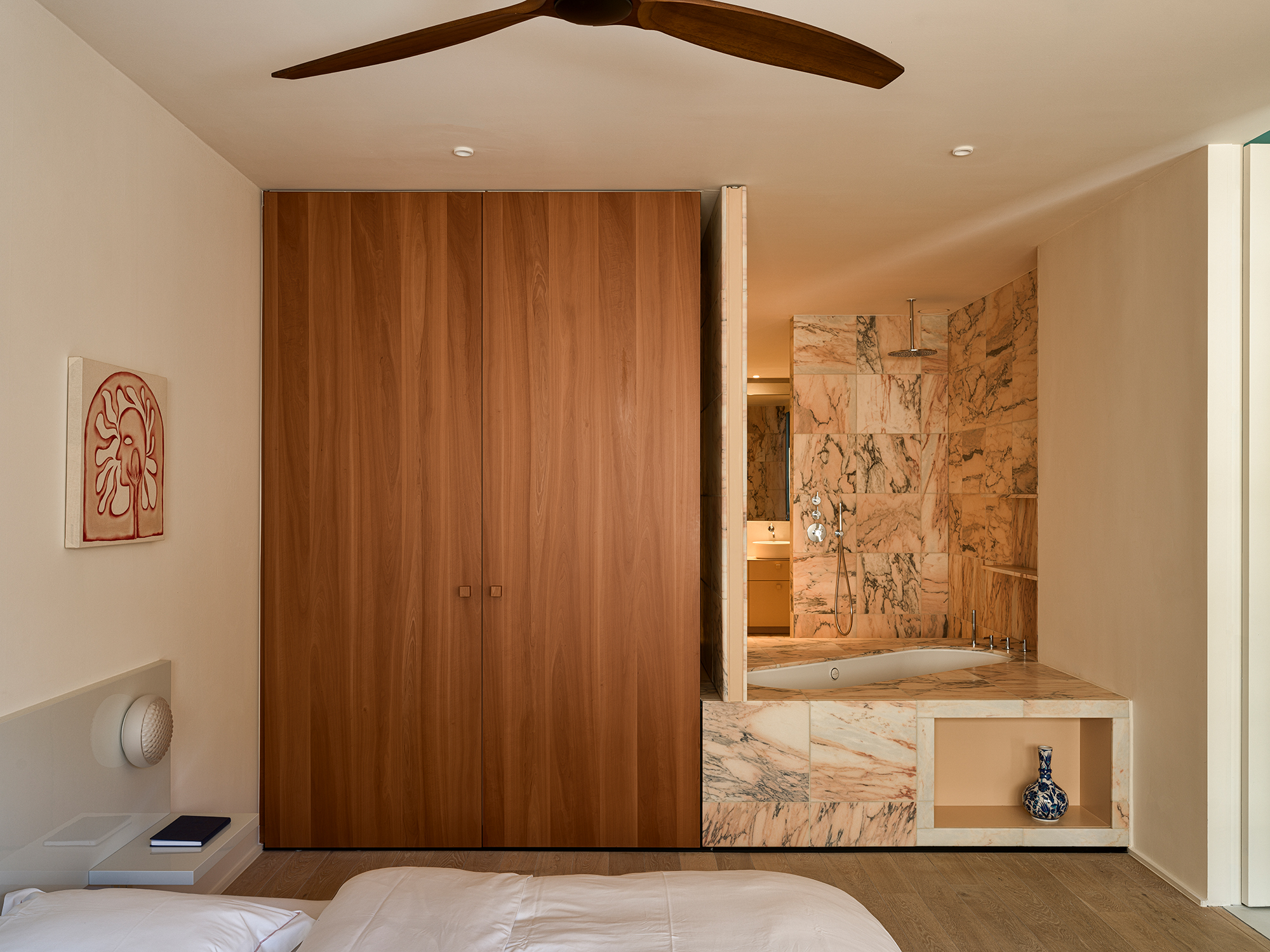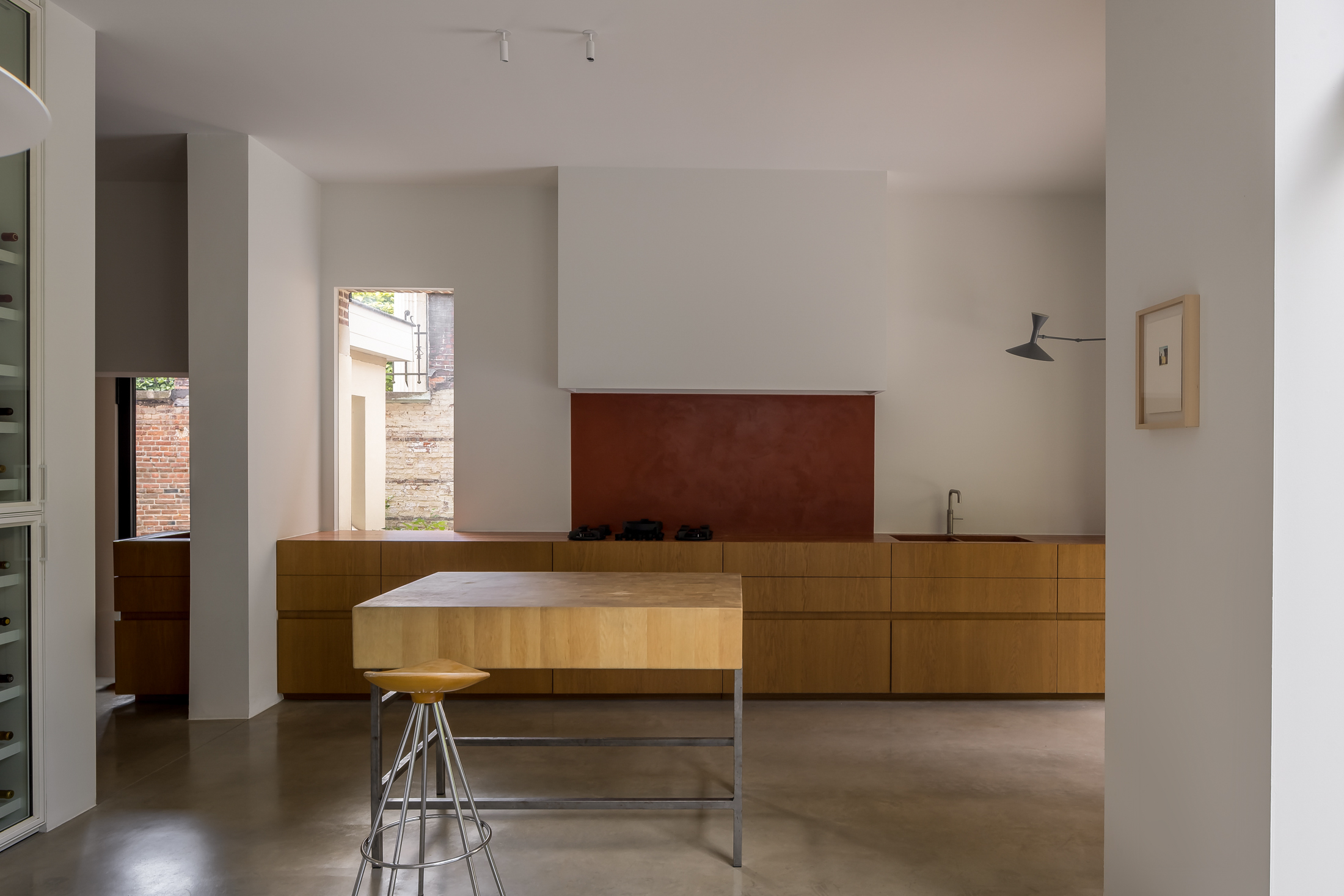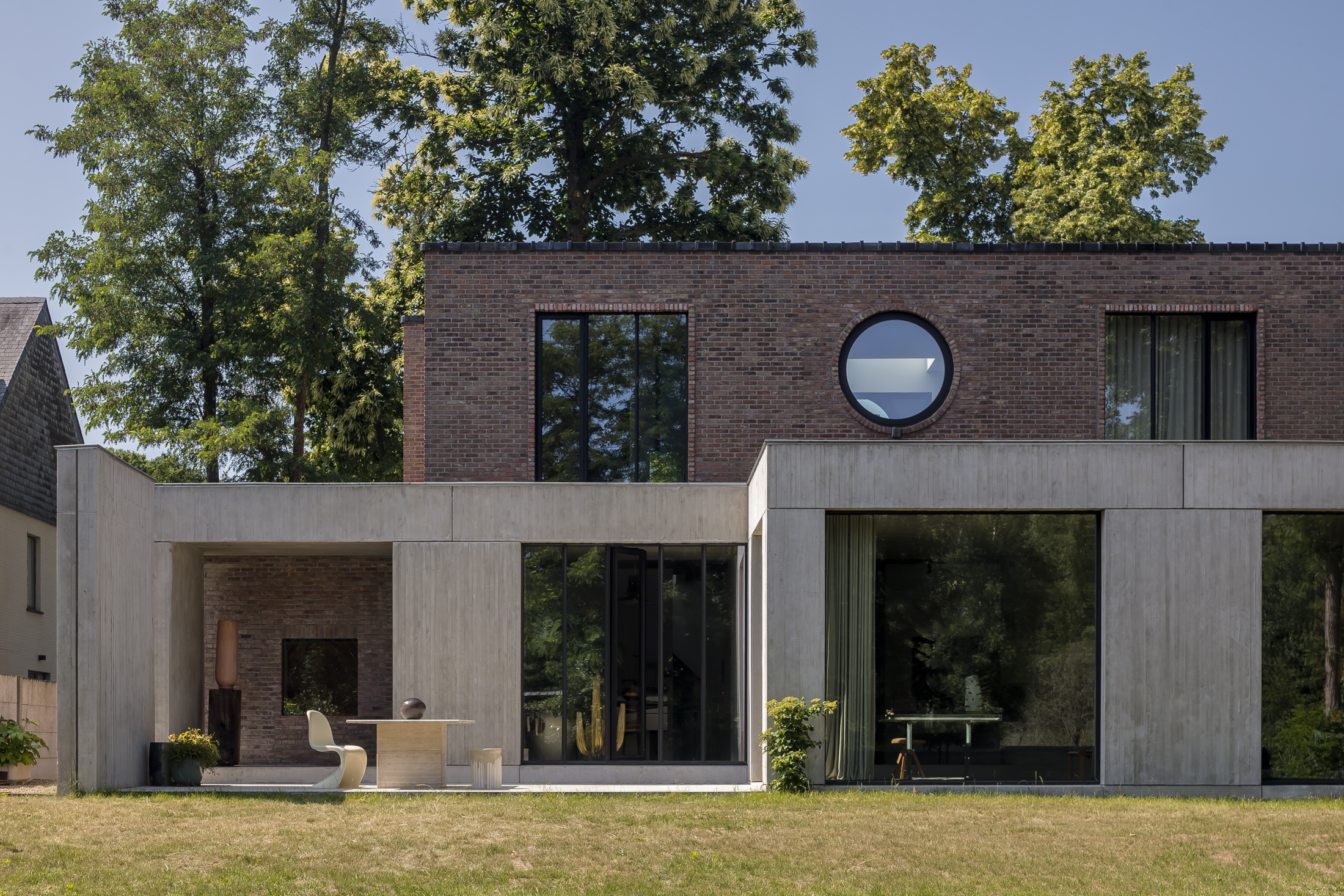Photography
Cafeine
Design team
Sam Peeters Iona Tettelin
Year
2023
Retail
Bonheiden
SALON R

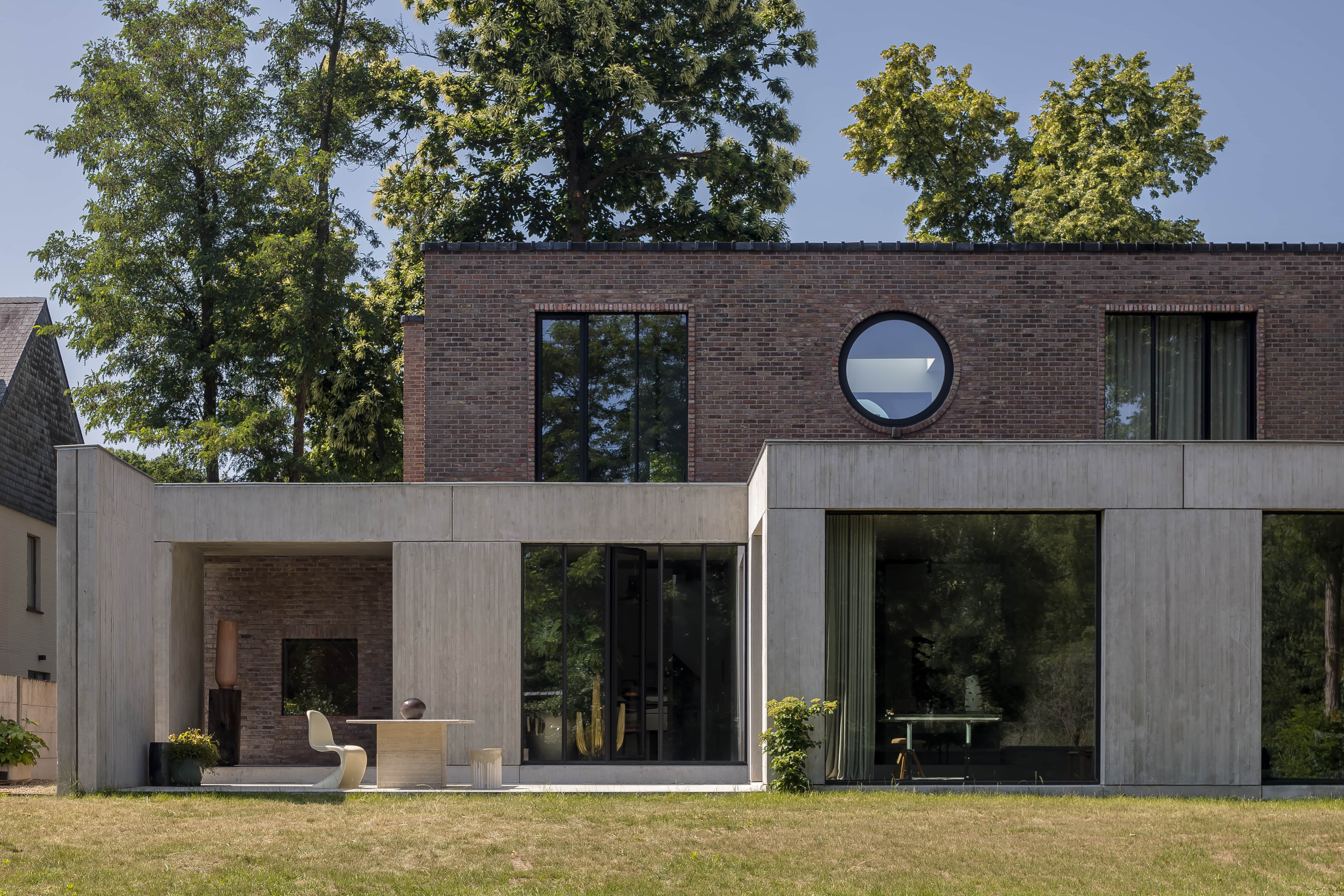
ARCHITECTURE In Bonheiden, a characterful yet aging property has been reimagined as a hybrid space — part private residence, part hair salon — for a deeply involved and visionary client. The result is Salon R, a contemporary and precisely detailed intervention that redefines the conventional boundaries between living and working. The front of the building accommodates the salon, while the private residence is tucked away at the rear, opening out onto a serene forest landscape. All floors were replaced with board-formed concrete, poured in situ, with custom-cast openings to integrate lighting and technical infrastructure. The architectural language continues in the new extensions, where cast concrete is again used to clearly delineate the added volumes from the original brickwork structure. This controlled material palette brings cohesion and clarity to the intervention. Collab, very pleasant by the way, with ADS architecture.
%20(1).jpg)
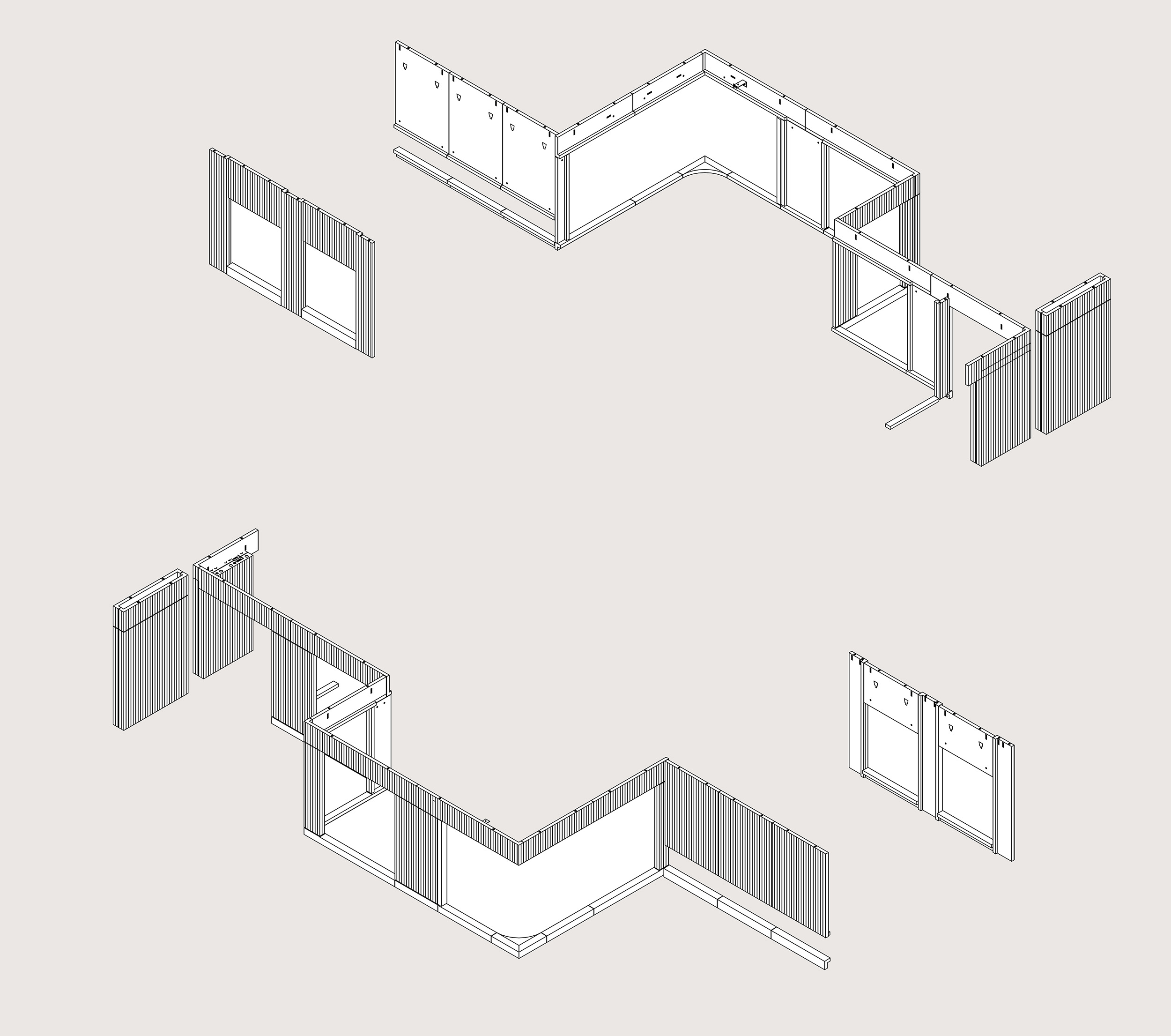
Floorplan
groundfloor of Salon R and the residence
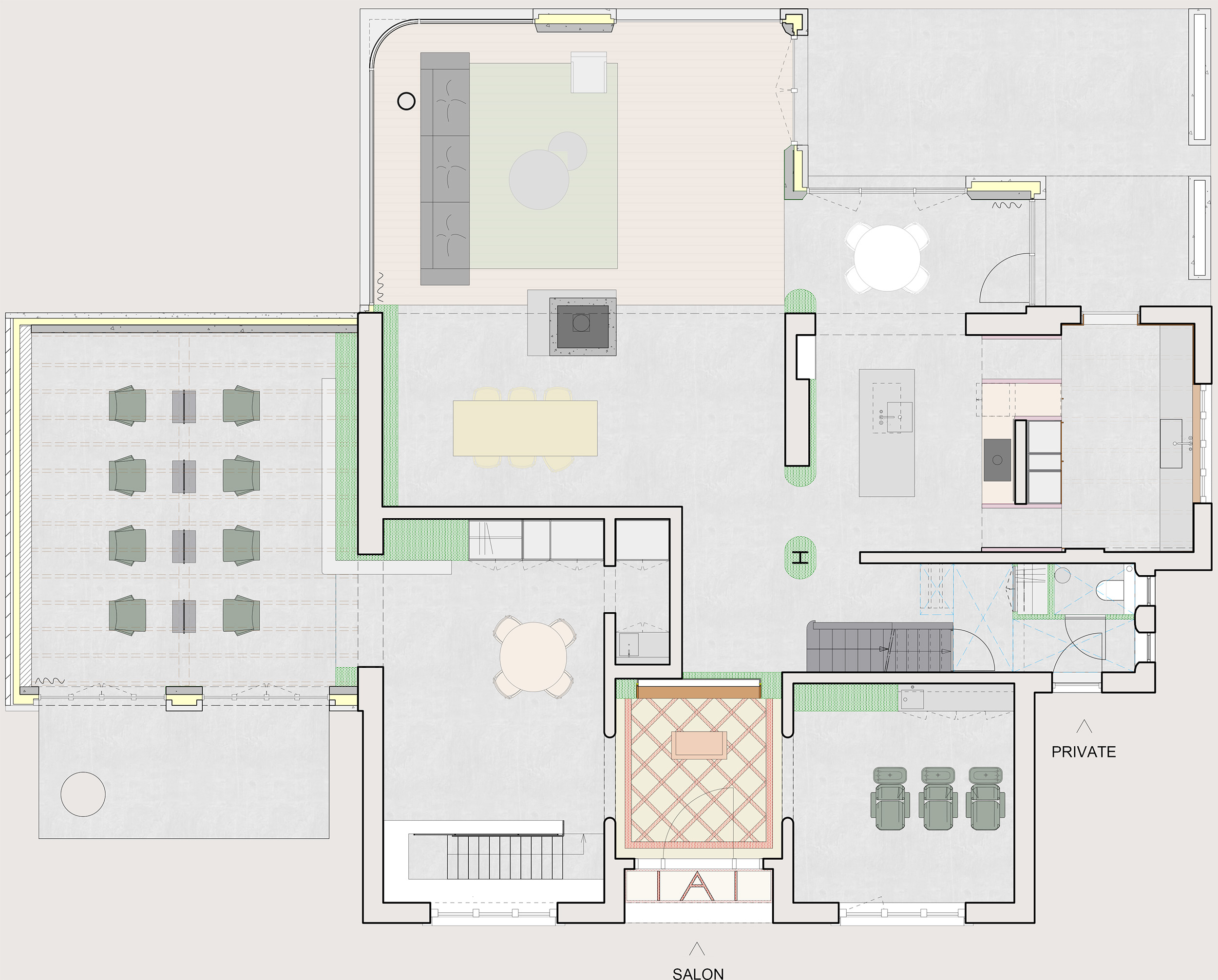
ARCHITECTURE In Bonheiden, a characterful yet aging property has been reimagined as a hybrid space — part private residence, part hair salon — for a deeply involved and visionary client. The result is Salon R, a contemporary and precisely detailed intervention that redefines the conventional boundaries between living and working. The front of the building accommodates the salon, while the private residence is tucked away at the rear, opening out onto a serene forest landscape. All floors were replaced with board-formed concrete, poured in situ, with custom-cast openings to integrate lighting and technical infrastructure. The architectural language continues in the new extensions, where cast concrete is again used to clearly delineate the added volumes from the original brickwork structure. This controlled material palette brings cohesion and clarity to the intervention. Collab, very pleasant by the way, with ADS architecture.
ARCHITECTURE In Bonheiden, a characterful yet aging property has been reimagined as a hybrid space — part private residence, part hair salon — for a deeply involved and visionary client. The result is Salon R, a contemporary and precisely detailed intervention that redefines the conventional boundaries between living and working. The front of the building accommodates the salon, while the private residence is tucked away at the rear, opening out onto a serene forest landscape. All floors were replaced with board-formed concrete, poured in situ, with custom-cast openings to integrate lighting and technical infrastructure. The architectural language continues in the new extensions, where cast concrete is again used to clearly delineate the added volumes from the original brickwork structure. This controlled material palette brings cohesion and clarity to the intervention. Collab, very pleasant by the way, with ADS architecture.

The architectural expression of both extensions is defined by the use of precast concrete façade panels, which were carefully “puzzled” into place on-site. This modular yet bespoke approach creates a quiet rhythm across both additions, clearly distinguishing them from the original structure while maintaining material coherence. The contrast between the rough texture of board-formed in-situ concrete floors and the precision of precast façades underscores the project's interest in layering, tactility, and craft. The smallest of the two new extensions replaces a former garage and storage volume, now rebuilt to house the hair salon. The larger extension forms the heart of the private home: a generous open-plan kitchen and living area, anchored by a curved window and a centrally placed fireplace.
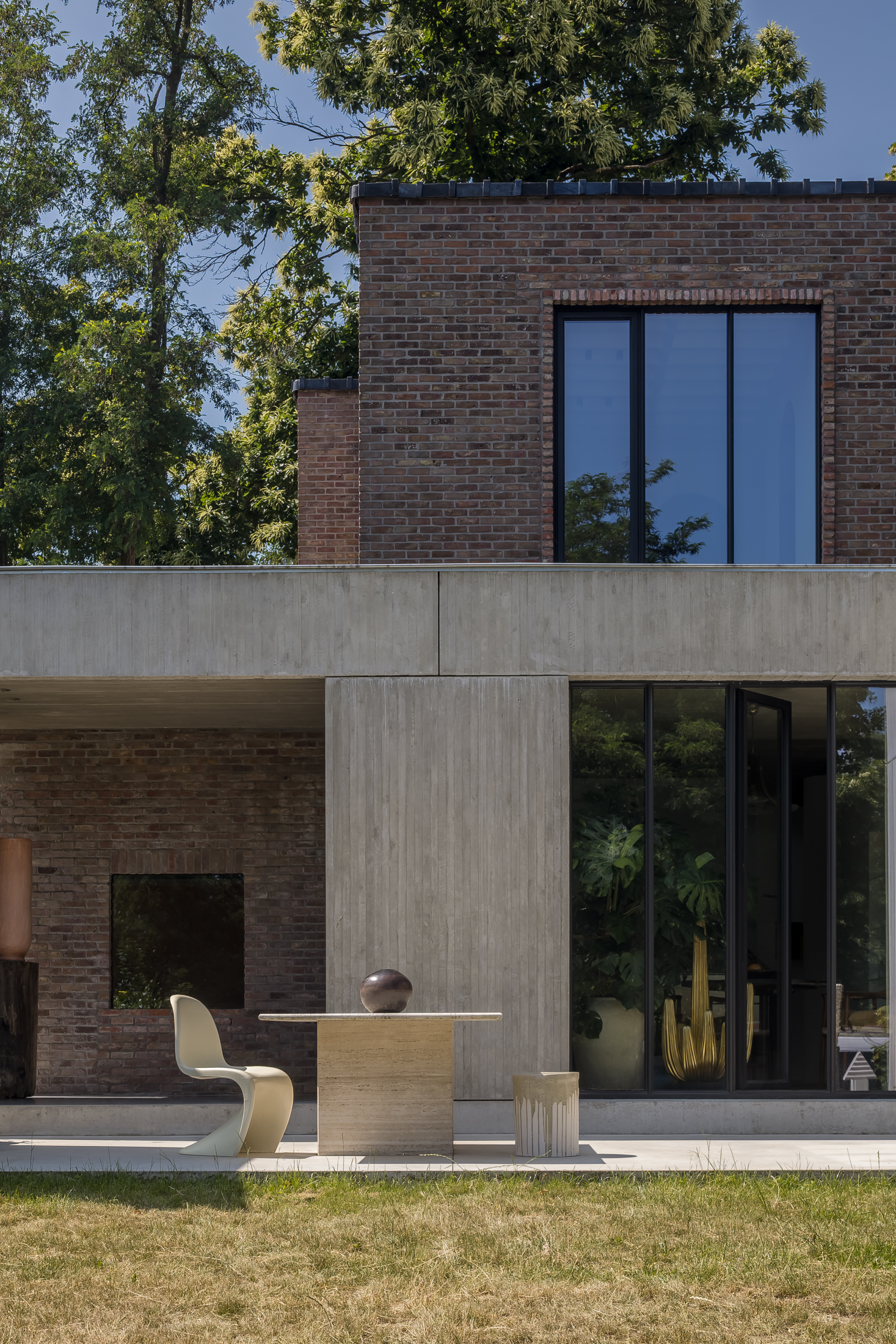





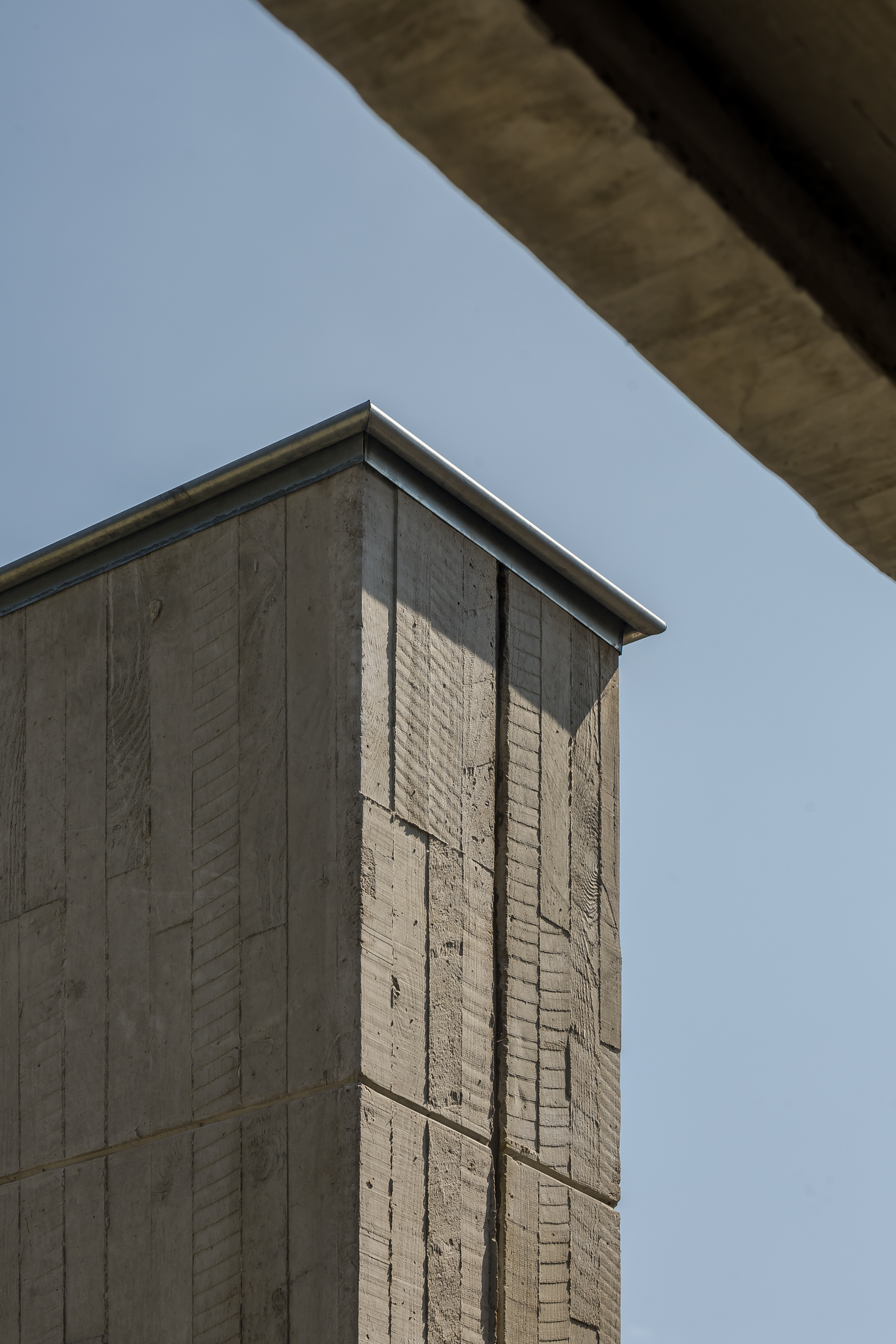








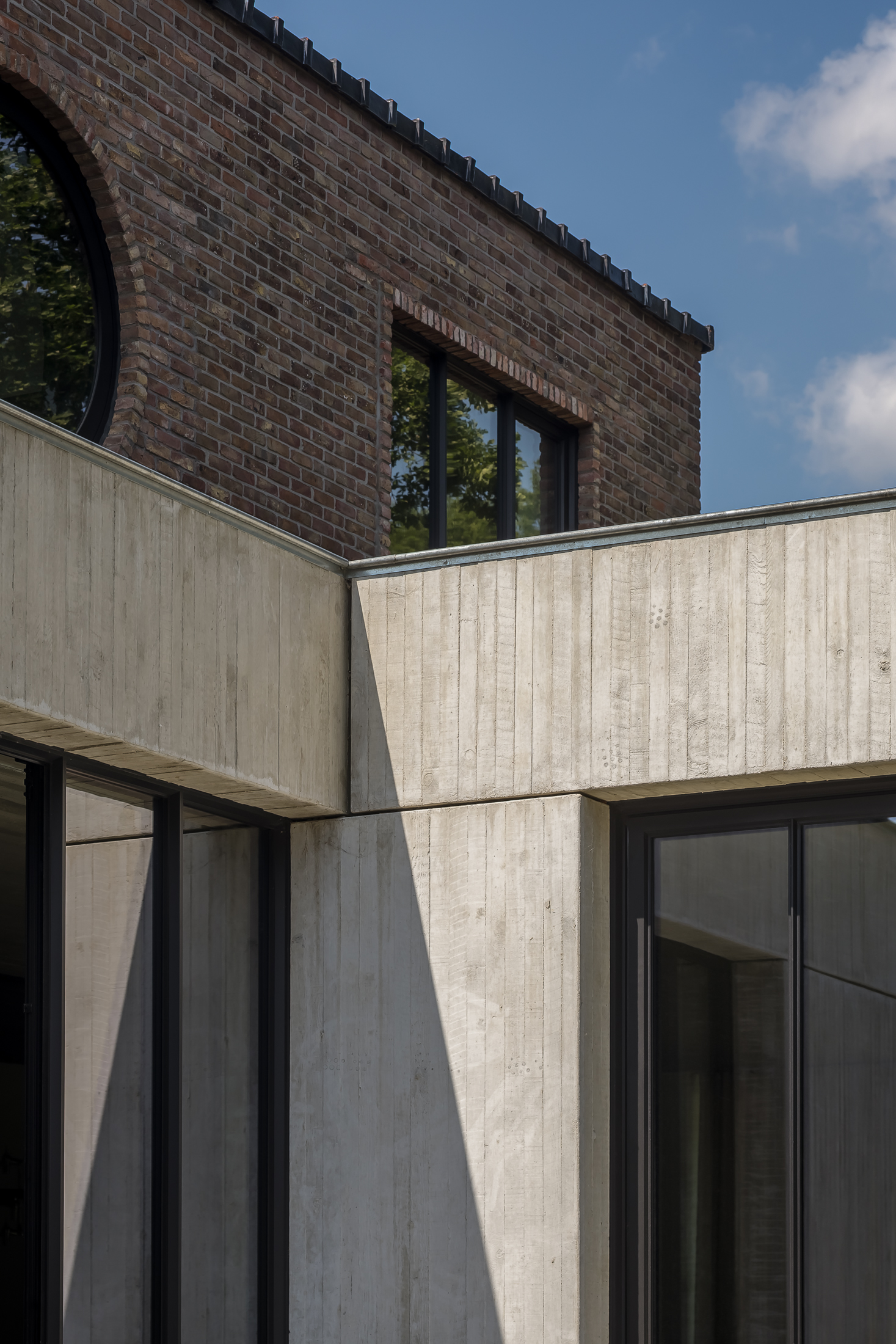





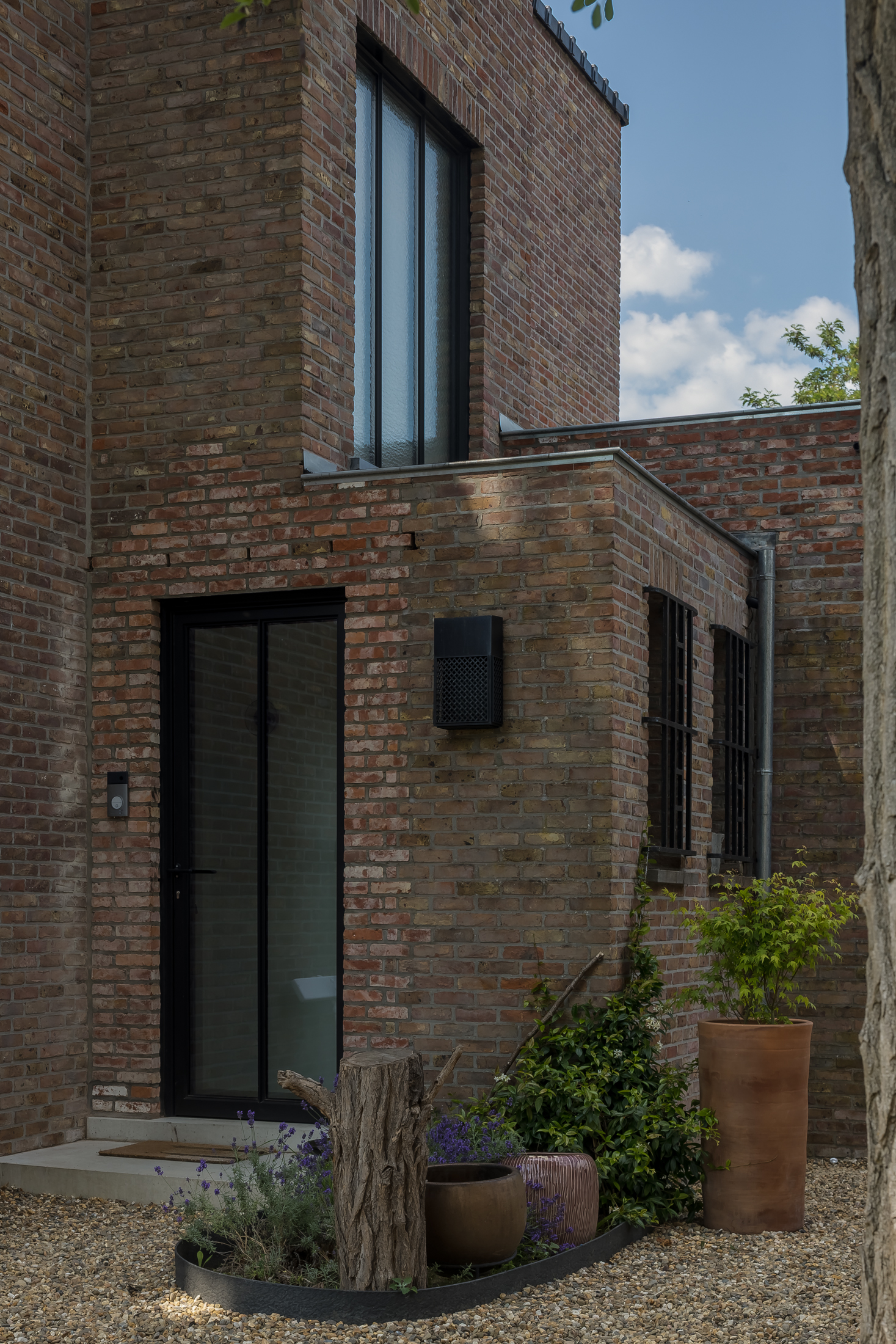

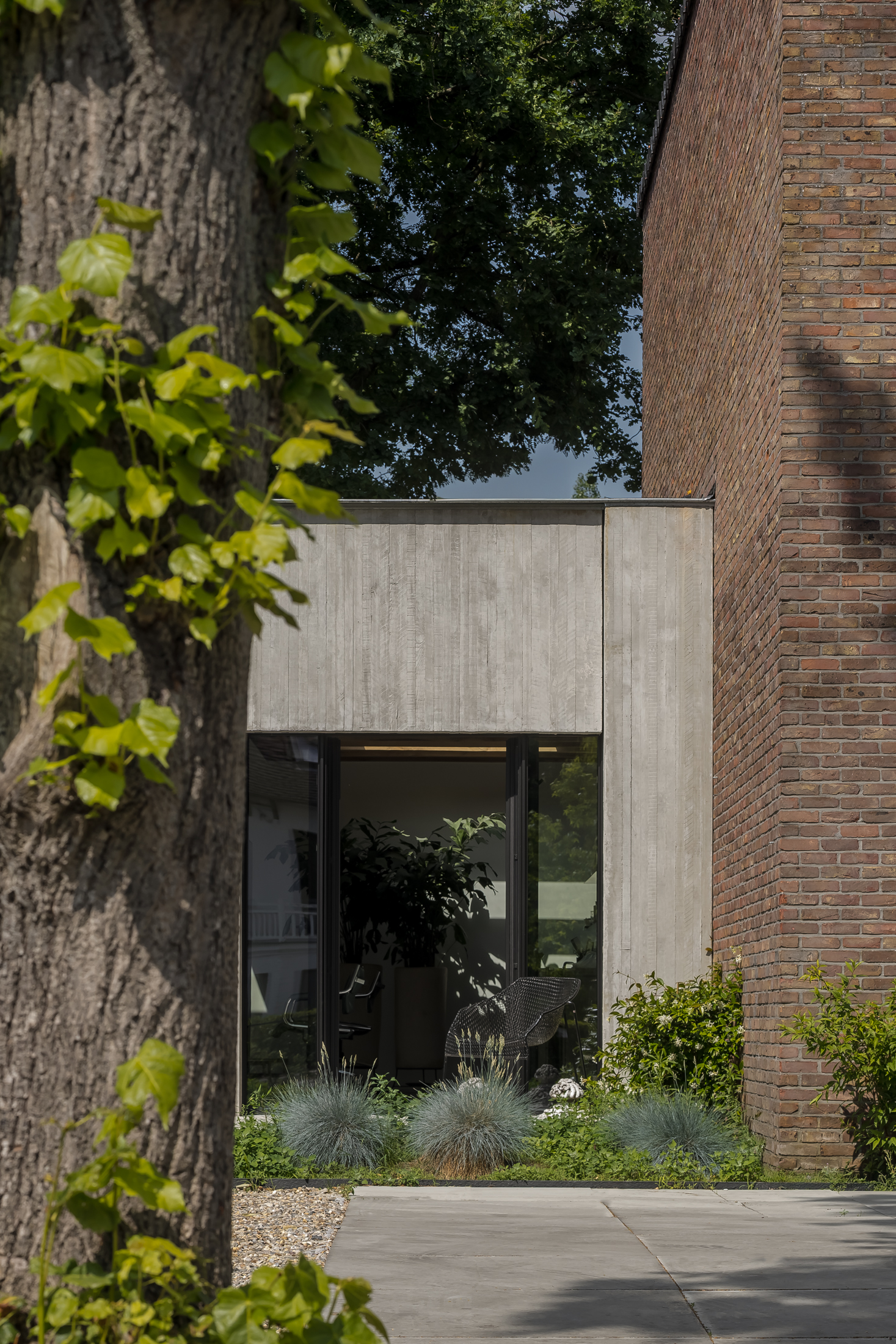






The architectural expression of both extensions is defined by the use of precast concrete façade panels, which were carefully “puzzled” into place on-site. This modular yet bespoke approach creates a quiet rhythm across both additions, clearly distinguishing them from the original structure while maintaining material coherence. The contrast between the rough texture of board-formed in-situ concrete floors and the precision of precast façades underscores the project's interest in layering, tactility, and craft. The smallest of the two new extensions replaces a former garage and storage volume, now rebuilt to house the hair salon. The larger extension forms the heart of the private home: a generous open-plan kitchen and living area, anchored by a curved window and a centrally placed fireplace.
The architectural expression of both extensions is defined by the use of precast concrete façade panels, which were carefully “puzzled” into place on-site. This modular yet bespoke approach creates a quiet rhythm across both additions, clearly distinguishing them from the original structure while maintaining material coherence. The contrast between the rough texture of board-formed in-situ concrete floors and the precision of precast façades underscores the project's interest in layering, tactility, and craft. The smallest of the two new extensions replaces a former garage and storage volume, now rebuilt to house the hair salon. The larger extension forms the heart of the private home: a generous open-plan kitchen and living area, anchored by a curved window and a centrally placed fireplace.

.jpg)
SALON A beautifully preserved terrazzo floor in the salon's entrance is one of the few original features that remains — almost everything else has been rebuilt or reimagined. The internal layout of the salon is structured around the specific rituals of hairdressing, with each function housed in its own spatial zone. Upon entry, guests are greeted at a check-out that doubles as the reception. To the right lies the washing and coloring area, furnished with generous, comfortable chairs. To the left, accessible through a rounded arch, a waiting area with a round table and coffee station offers a welcoming pause.
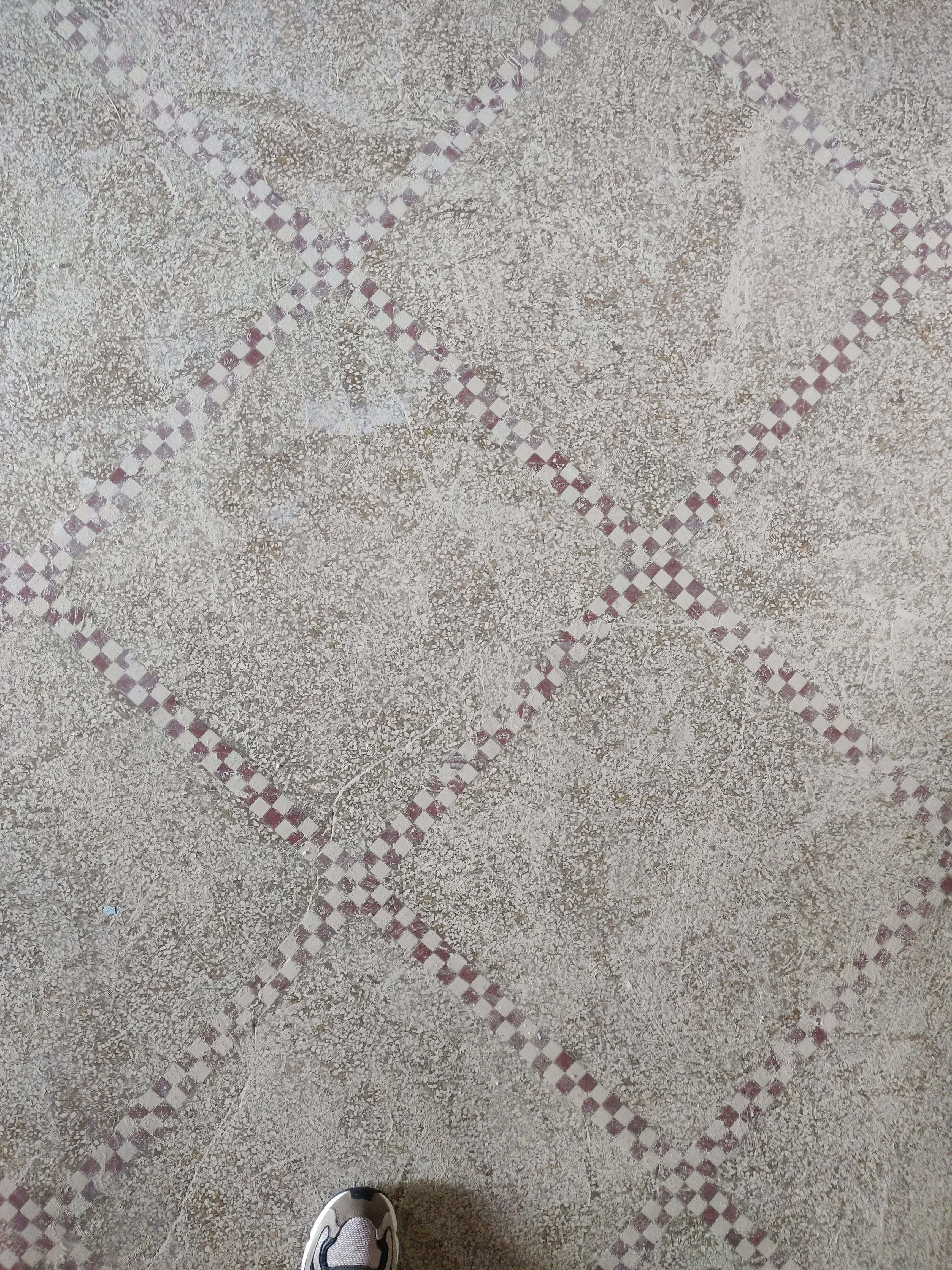
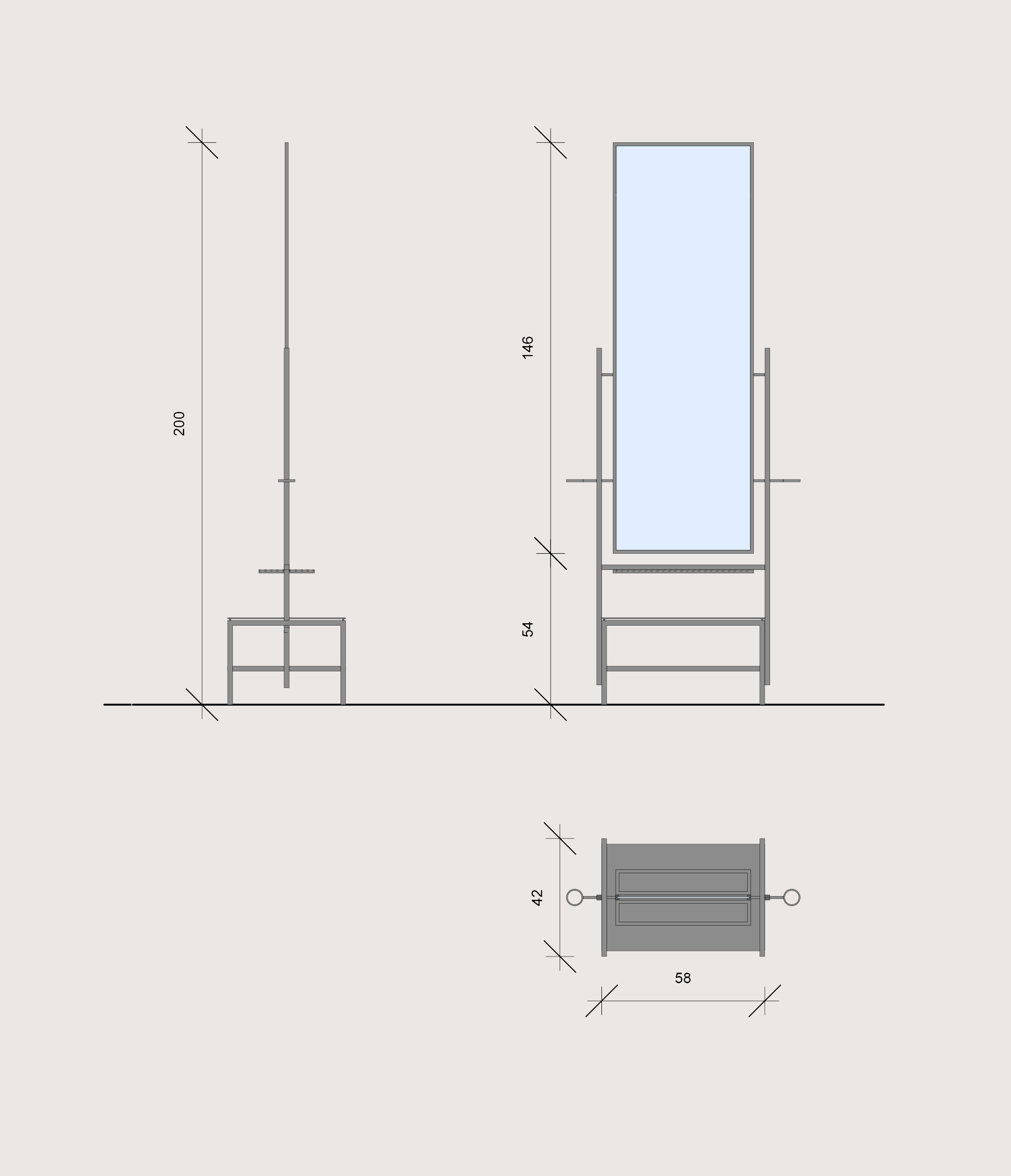
Mirror element
SALON A beautifully preserved terrazzo floor in the salon's entrance is one of the few original features that remains — almost everything else has been rebuilt or reimagined. The internal layout of the salon is structured around the specific rituals of hairdressing, with each function housed in its own spatial zone. Upon entry, guests are greeted at a check-out that doubles as the reception. To the right lies the washing and coloring area, furnished with generous, comfortable chairs. To the left, accessible through a rounded arch, a waiting area with a round table and coffee station offers a welcoming pause.
SALON A beautifully preserved terrazzo floor in the salon's entrance is one of the few original features that remains — almost everything else has been rebuilt or reimagined. The internal layout of the salon is structured around the specific rituals of hairdressing, with each function housed in its own spatial zone. Upon entry, guests are greeted at a check-out that doubles as the reception. To the right lies the washing and coloring area, furnished with generous, comfortable chairs. To the left, accessible through a rounded arch, a waiting area with a round table and coffee station offers a welcoming pause.

Storage cabinetry, which doubles as a vestiaire, runs through into a back-of-house sink and utility zone. Above, a bespoke ceiling grid subtly conceals ventilation, heating, and audio systems, maintaining a clean and calm interior aesthetic. A staircase leads clients to the basement, where the toilets feature bright yellow zellige tiles — a direct nod to the Moroccan heritage of the client, adding a personal and vibrant touch to the material narrative.
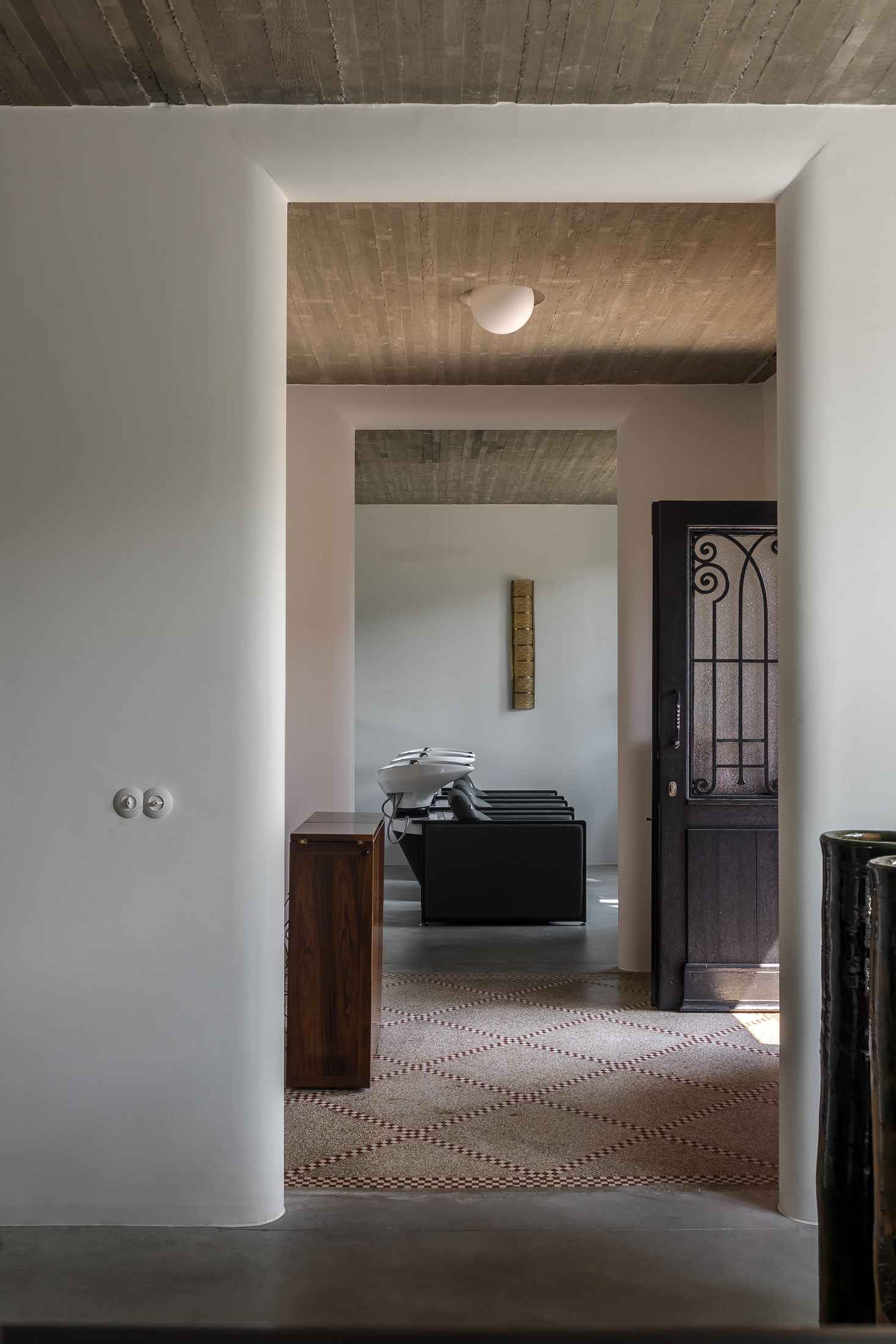





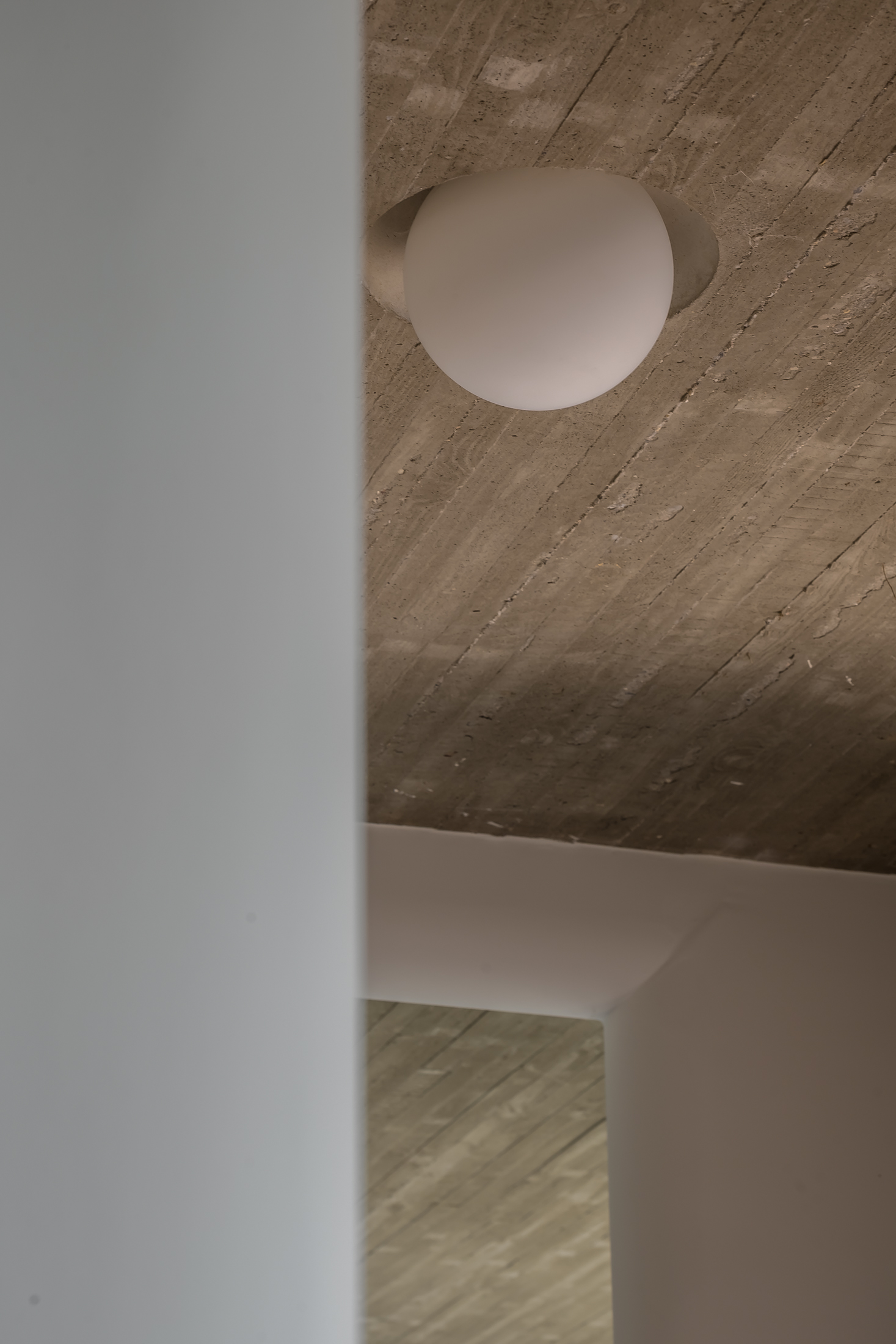





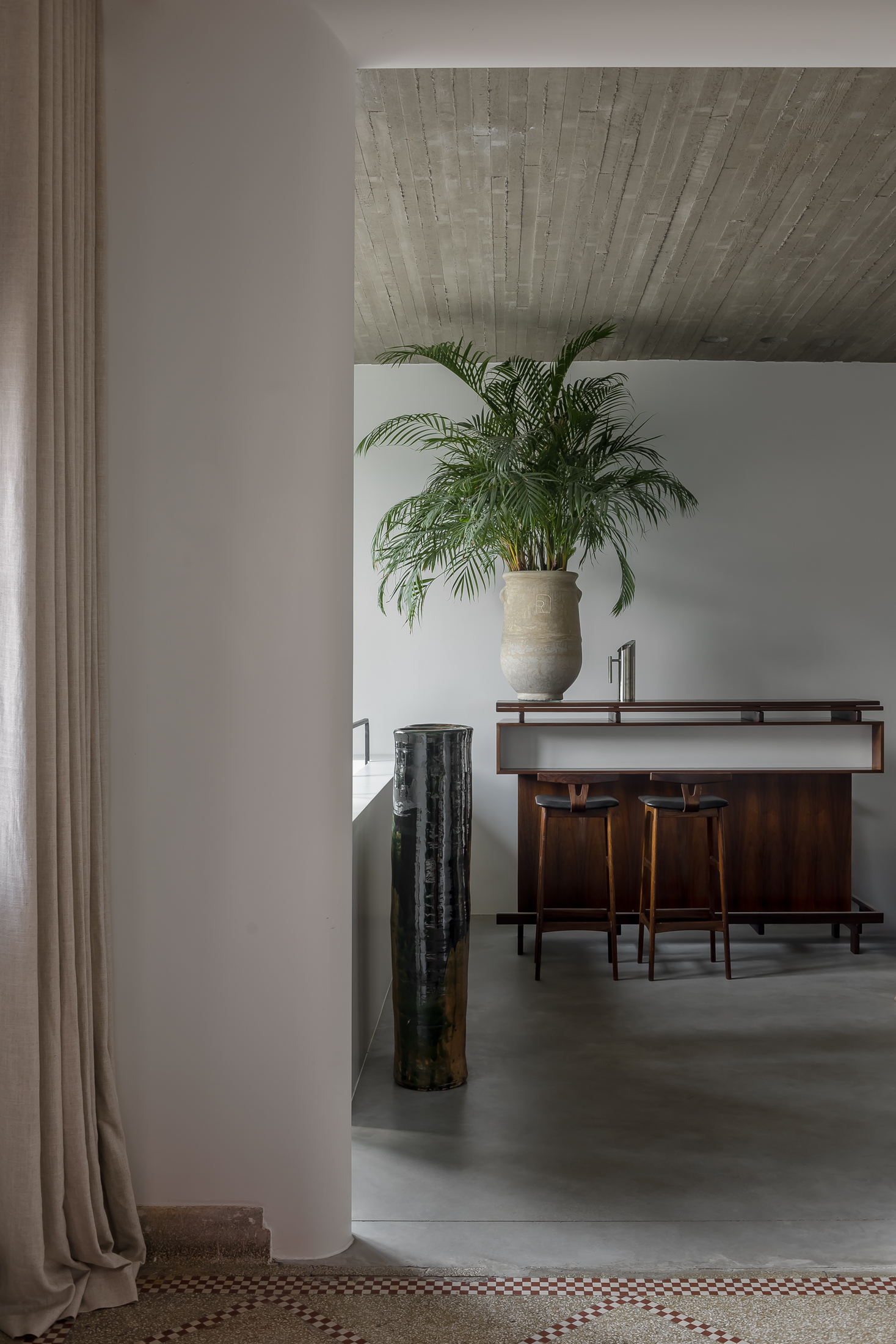


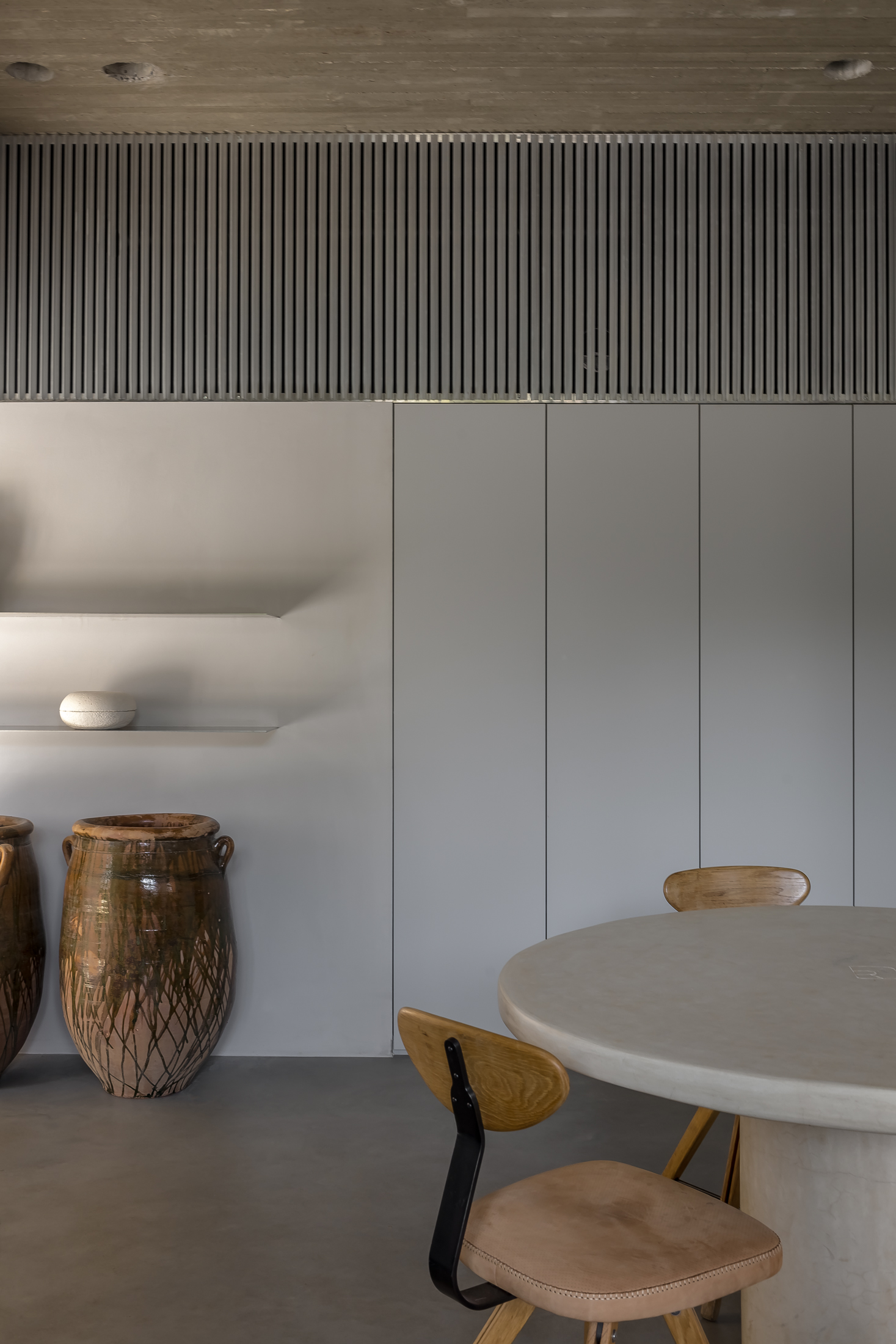

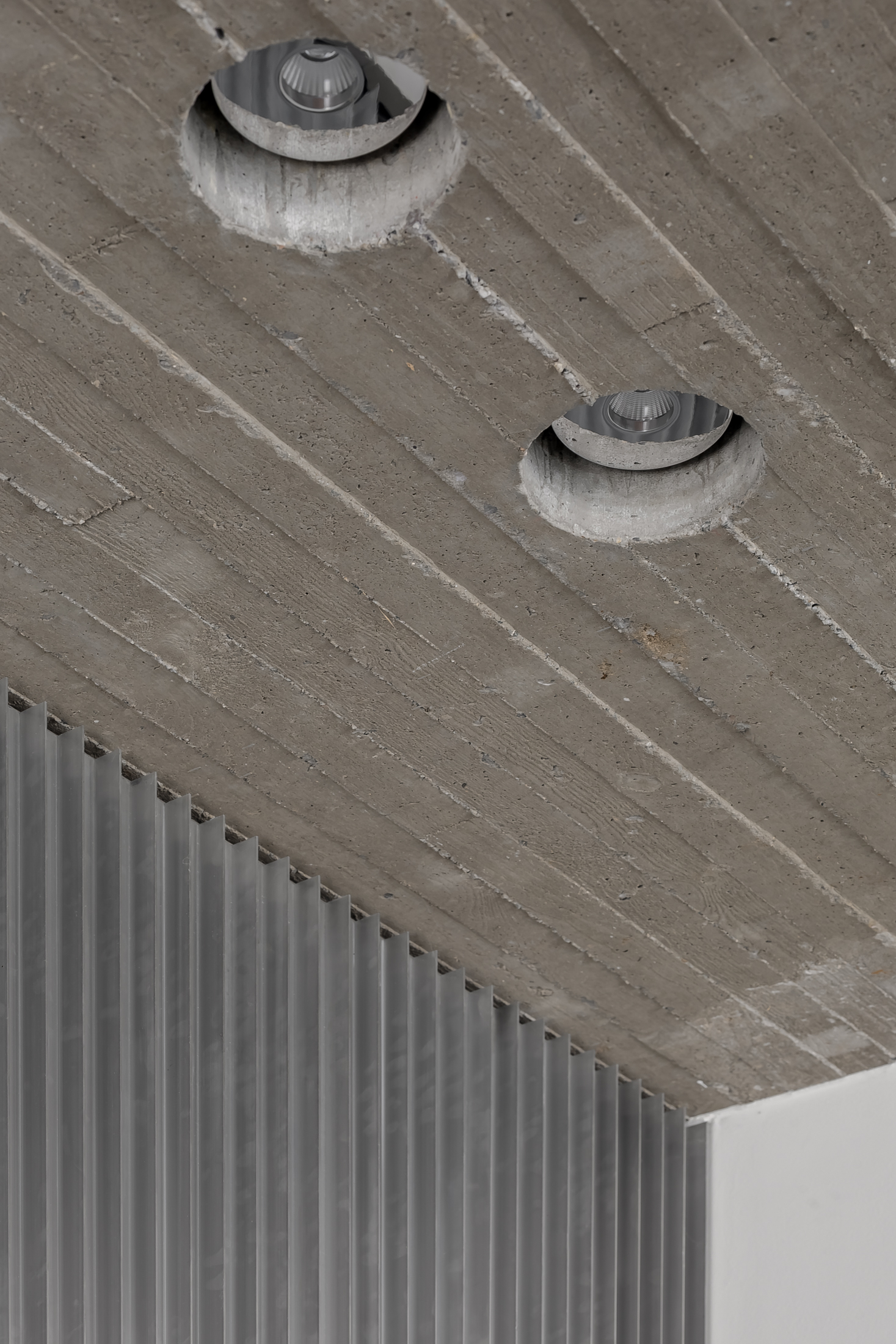






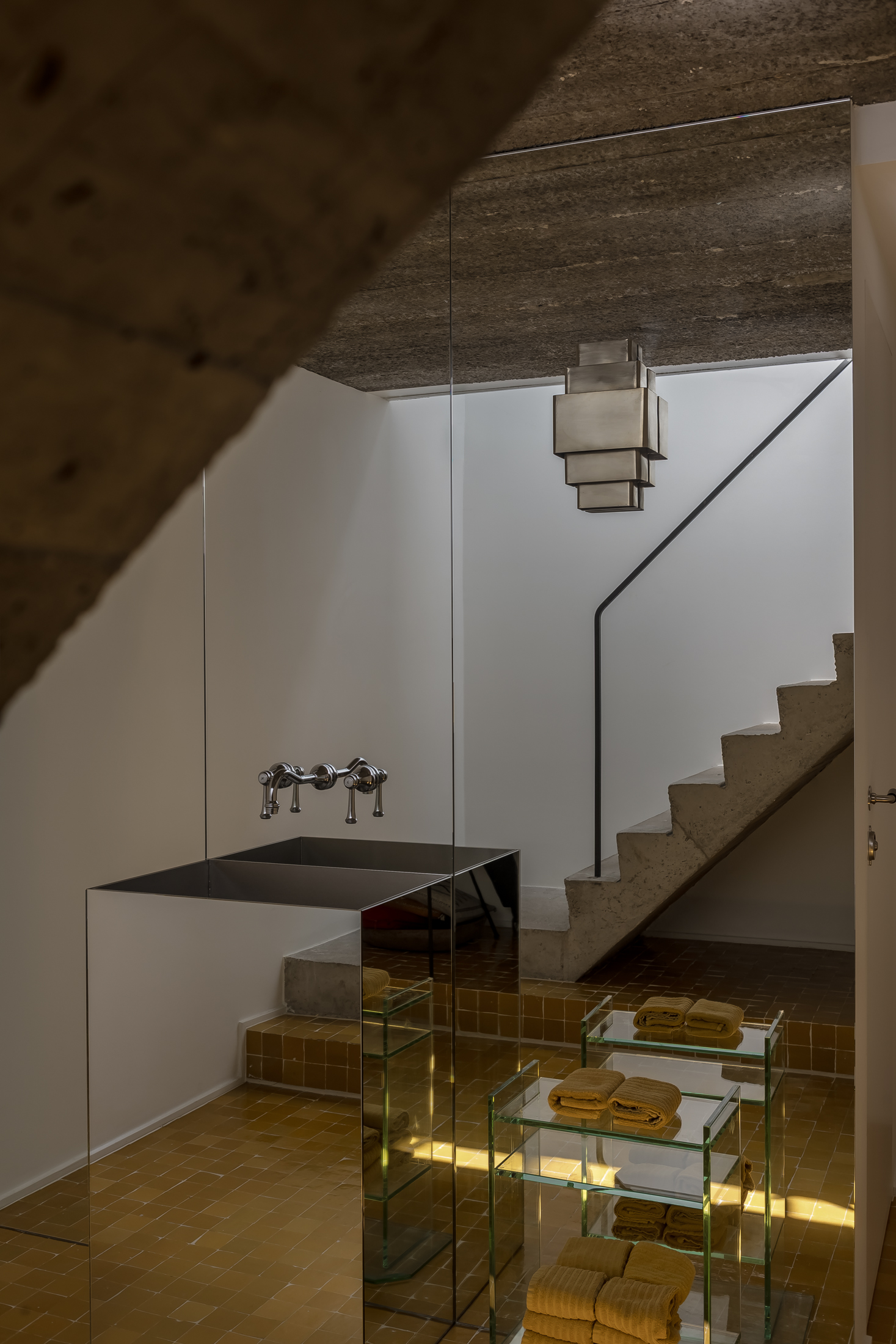

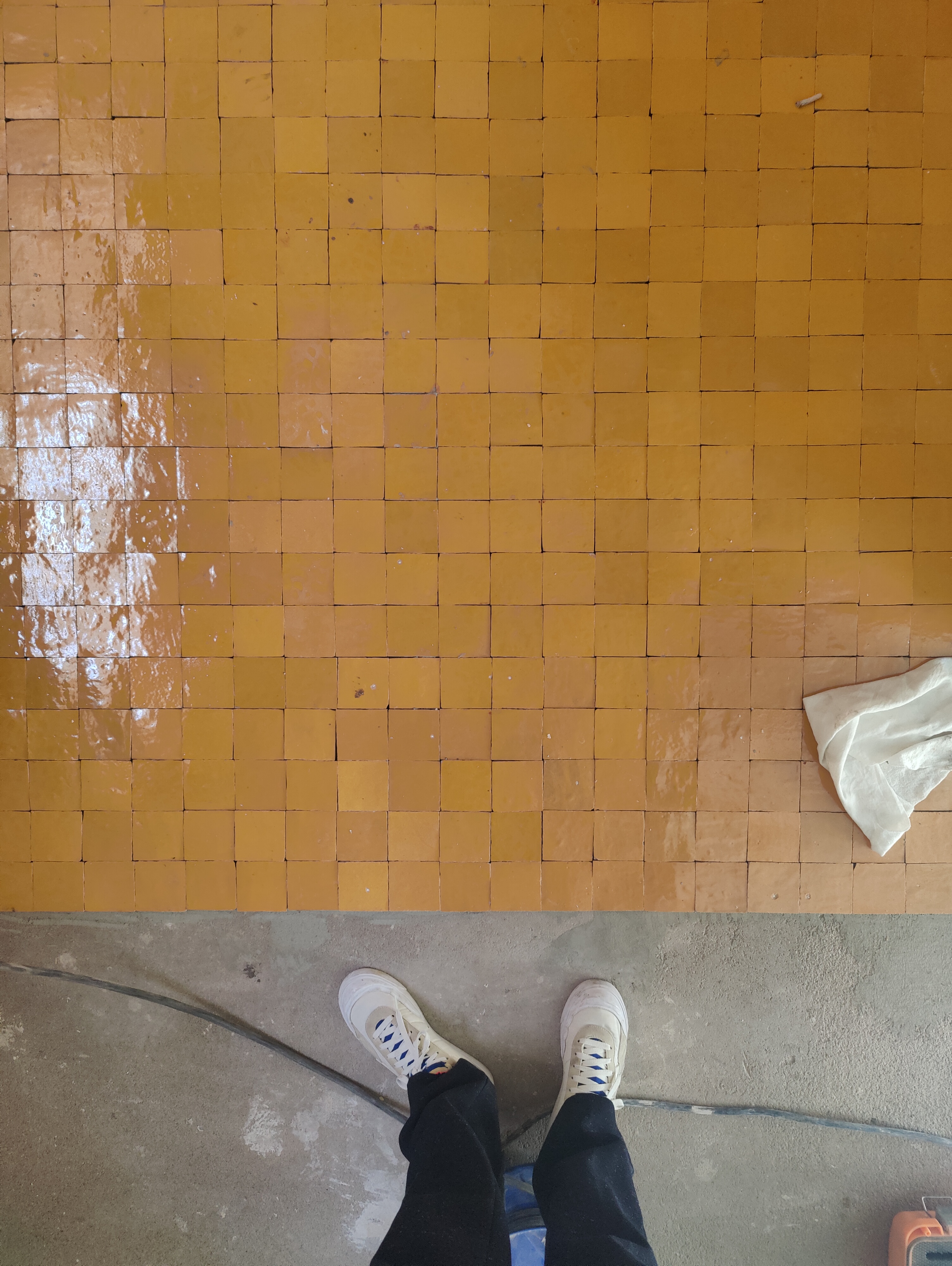






Storage cabinetry, which doubles as a vestiaire, runs through into a back-of-house sink and utility zone. Above, a bespoke ceiling grid subtly conceals ventilation, heating, and audio systems, maintaining a clean and calm interior aesthetic. A staircase leads clients to the basement, where the toilets feature bright yellow zellige tiles — a direct nod to the Moroccan heritage of the client, adding a personal and vibrant touch to the material narrative.
Storage cabinetry, which doubles as a vestiaire, runs through into a back-of-house sink and utility zone. Above, a bespoke ceiling grid subtly conceals ventilation, heating, and audio systems, maintaining a clean and calm interior aesthetic. A staircase leads clients to the basement, where the toilets feature bright yellow zellige tiles — a direct nod to the Moroccan heritage of the client, adding a personal and vibrant touch to the material narrative.

The primary salon activity cutting, is housed in a new extension at the back of the building. Here, a timber ceiling introduces warmth and acoustic softness, contrasting with the robust concrete floor that continues throughout all spaces. Flexibility was a central request in the brief. The client envisioned a space that could accommodate up to eight clients simultaneously, depending on the arrangement. To answer this, we designed a bespoke mobile cutting station in stainless steel: lightweight, mirrored, and double-sided. While its main function is the mirror, the unit is "loaded" with practical details — a hairdryer holder, integrated footrest, drink shelf, and even space for a handbag — merging efficiency with elegance.
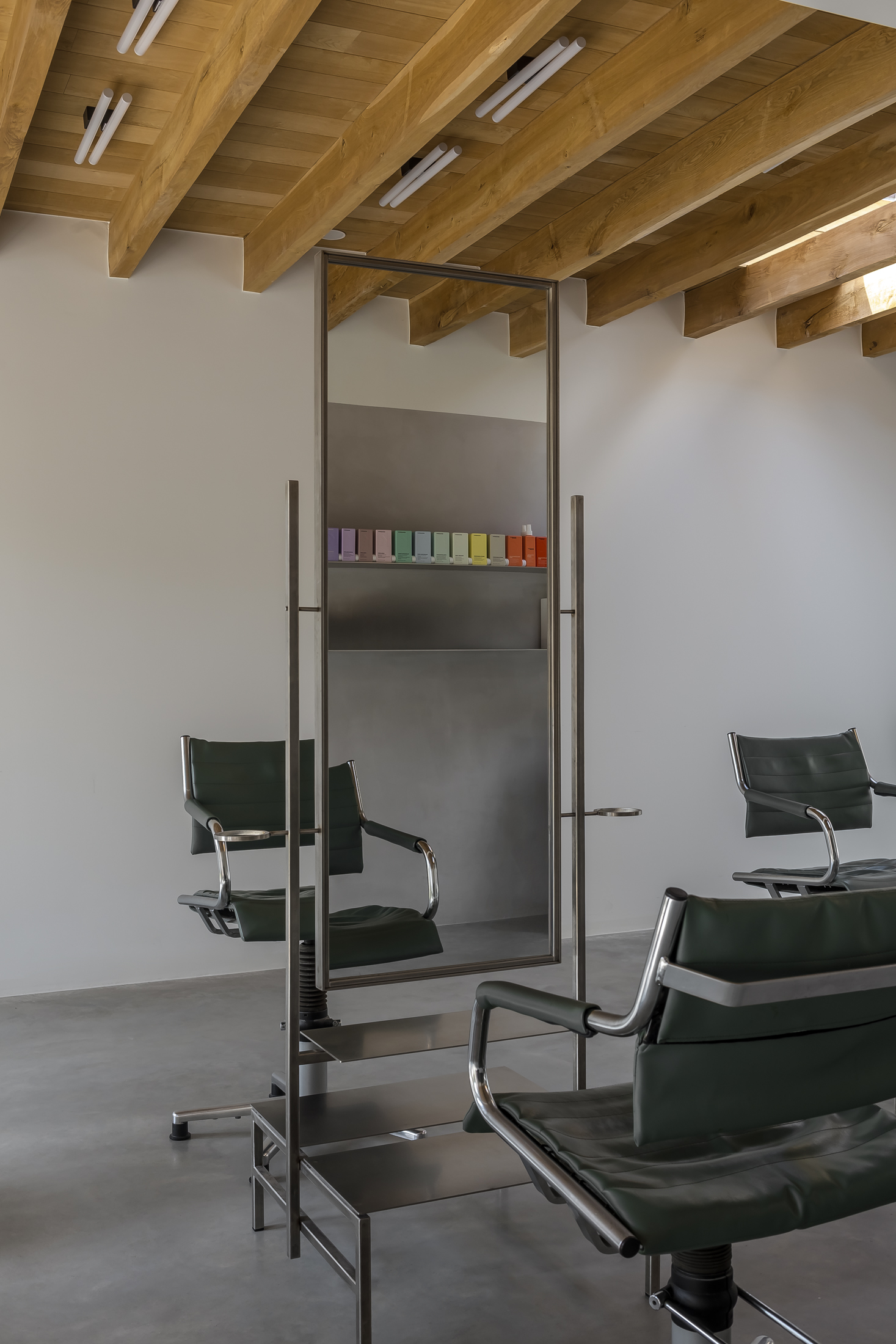





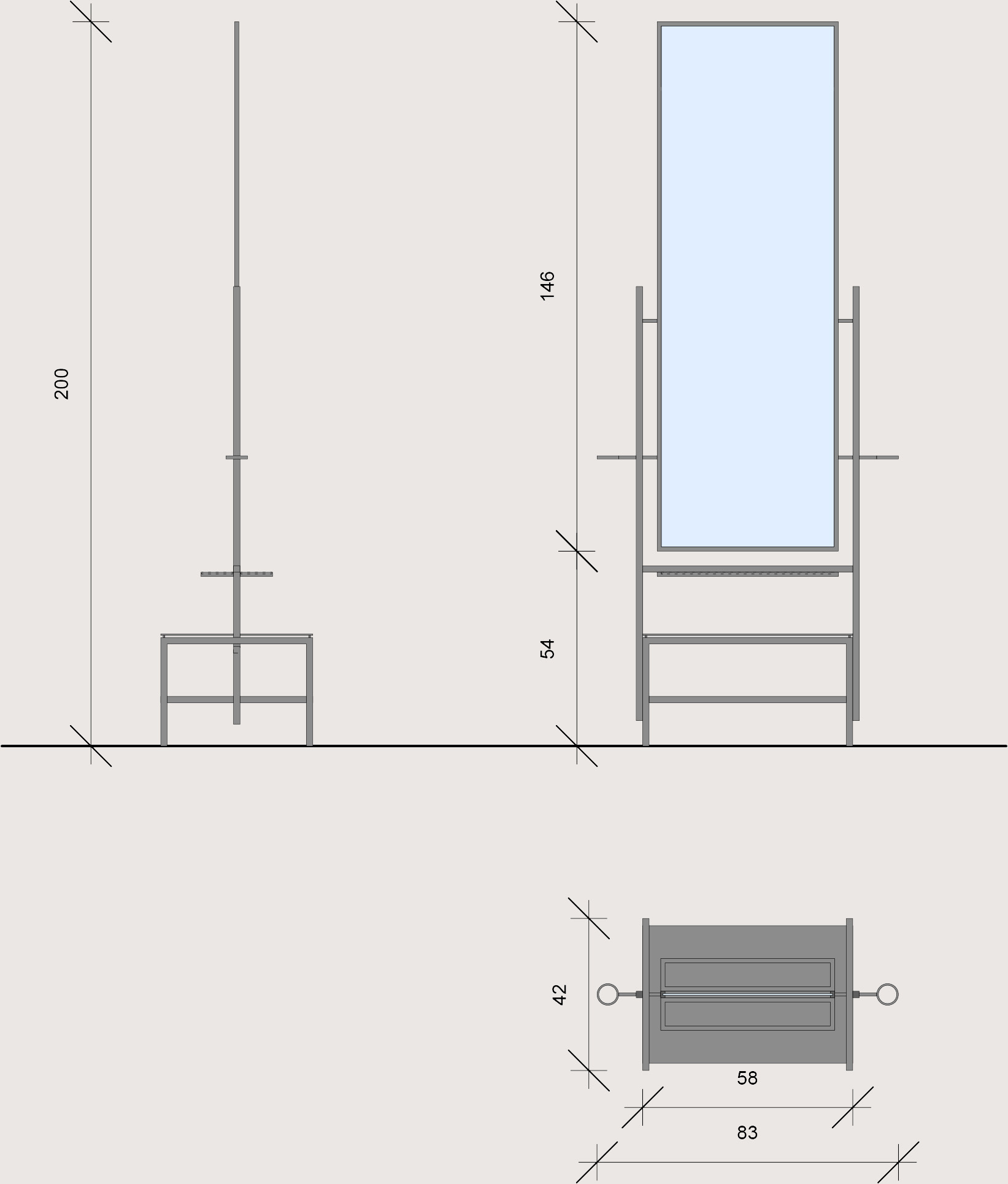

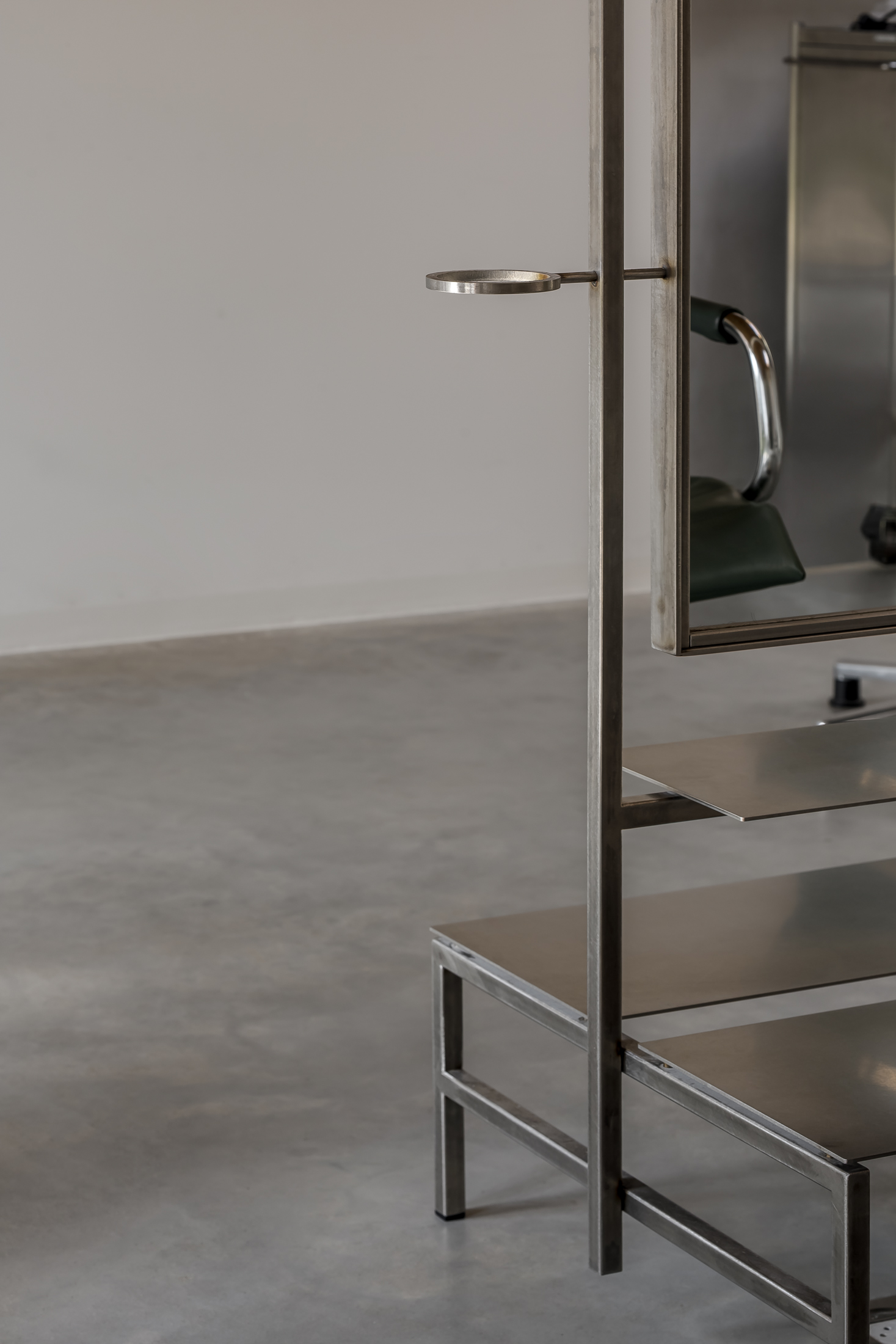






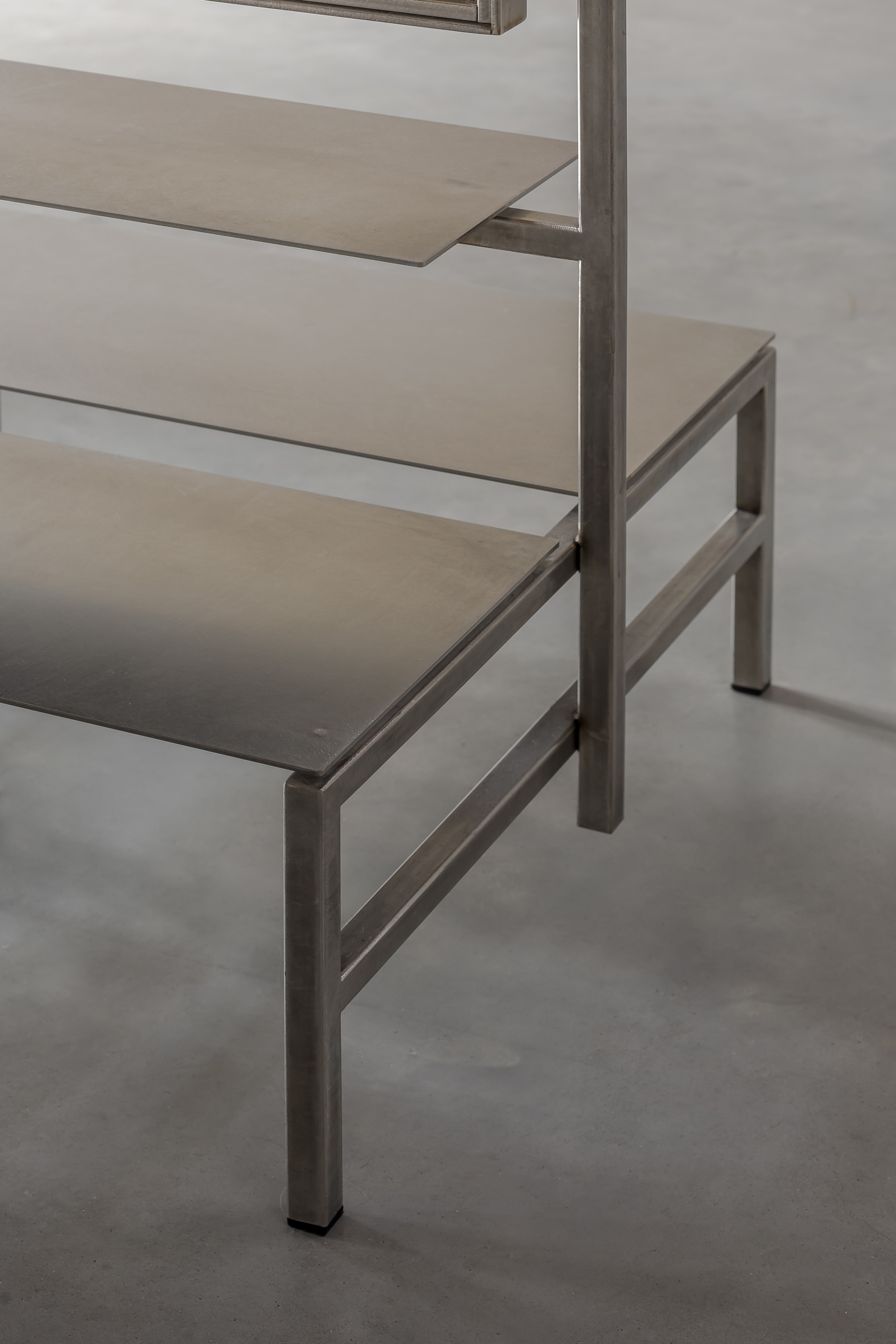








The primary salon activity cutting, is housed in a new extension at the back of the building. Here, a timber ceiling introduces warmth and acoustic softness, contrasting with the robust concrete floor that continues throughout all spaces. Flexibility was a central request in the brief. The client envisioned a space that could accommodate up to eight clients simultaneously, depending on the arrangement. To answer this, we designed a bespoke mobile cutting station in stainless steel: lightweight, mirrored, and double-sided. While its main function is the mirror, the unit is "loaded" with practical details — a hairdryer holder, integrated footrest, drink shelf, and even space for a handbag — merging efficiency with elegance.
The primary salon activity cutting, is housed in a new extension at the back of the building. Here, a timber ceiling introduces warmth and acoustic softness, contrasting with the robust concrete floor that continues throughout all spaces. Flexibility was a central request in the brief. The client envisioned a space that could accommodate up to eight clients simultaneously, depending on the arrangement. To answer this, we designed a bespoke mobile cutting station in stainless steel: lightweight, mirrored, and double-sided. While its main function is the mirror, the unit is "loaded" with practical details — a hairdryer holder, integrated footrest, drink shelf, and even space for a handbag — merging efficiency with elegance.

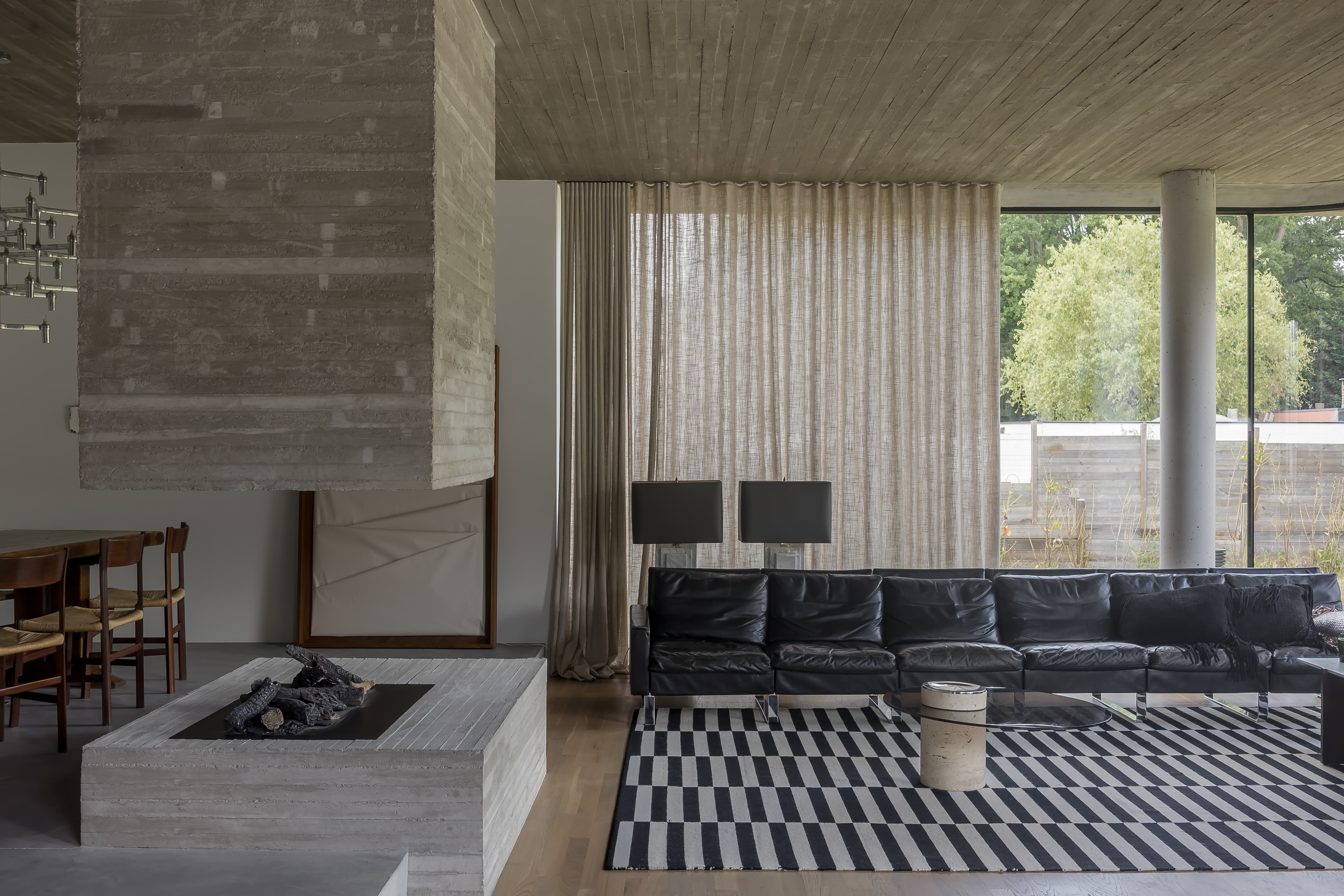
PRIVATE Access to the open-plan residence is through a modest side entrance, where the owner's identity is subtly reflected in the choice of materials. The concrete extension is complemented by handmade Zellige tiles, again nodding to the owner’s Moroccan heritage. The material palette features wooden floors, stainless steel elements, exposed beam ceilings, high-gloss black lacquer, and other rich finishes — brought to life through an eclectic mix of furniture.

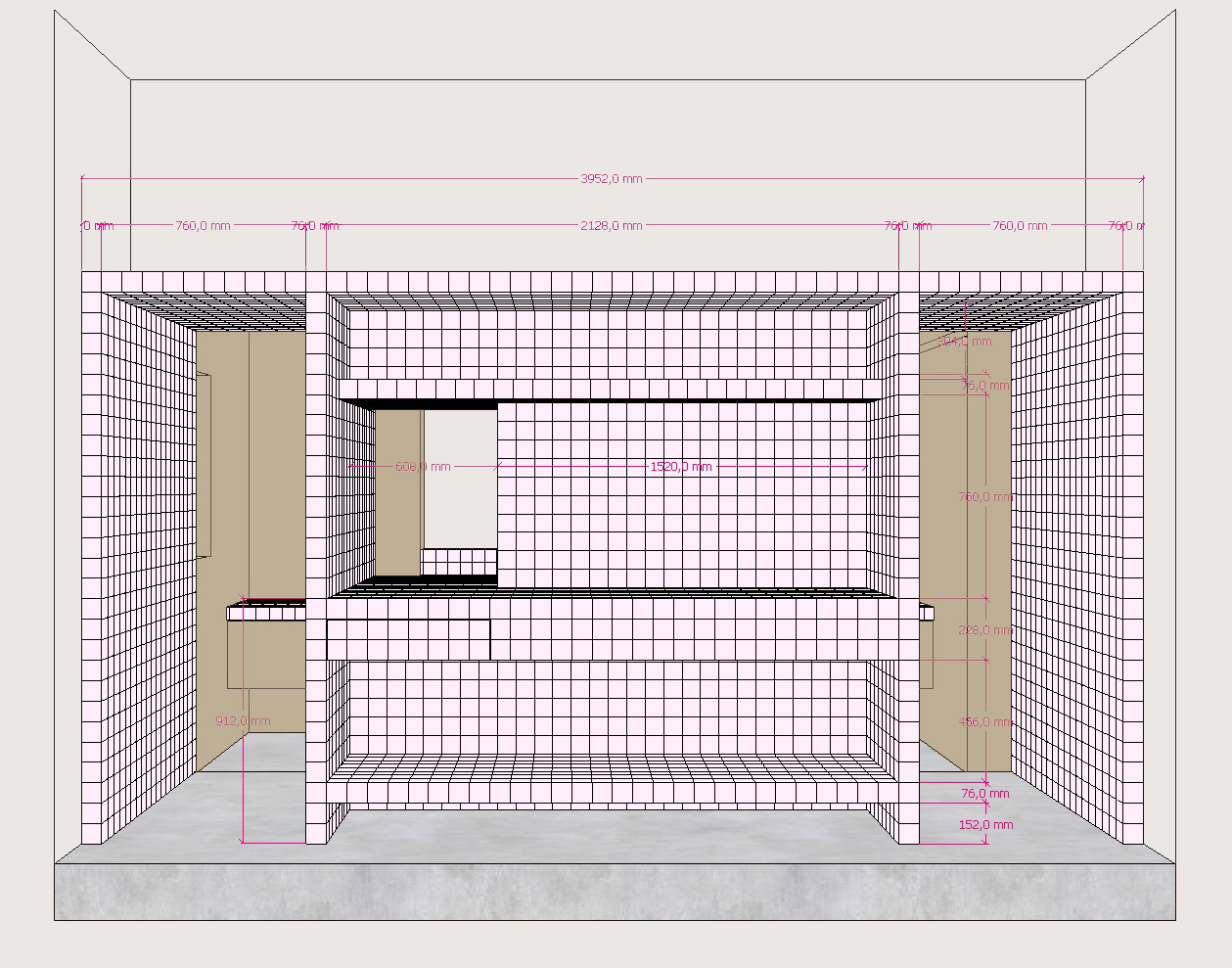
Section
Master bathroom tile pattern
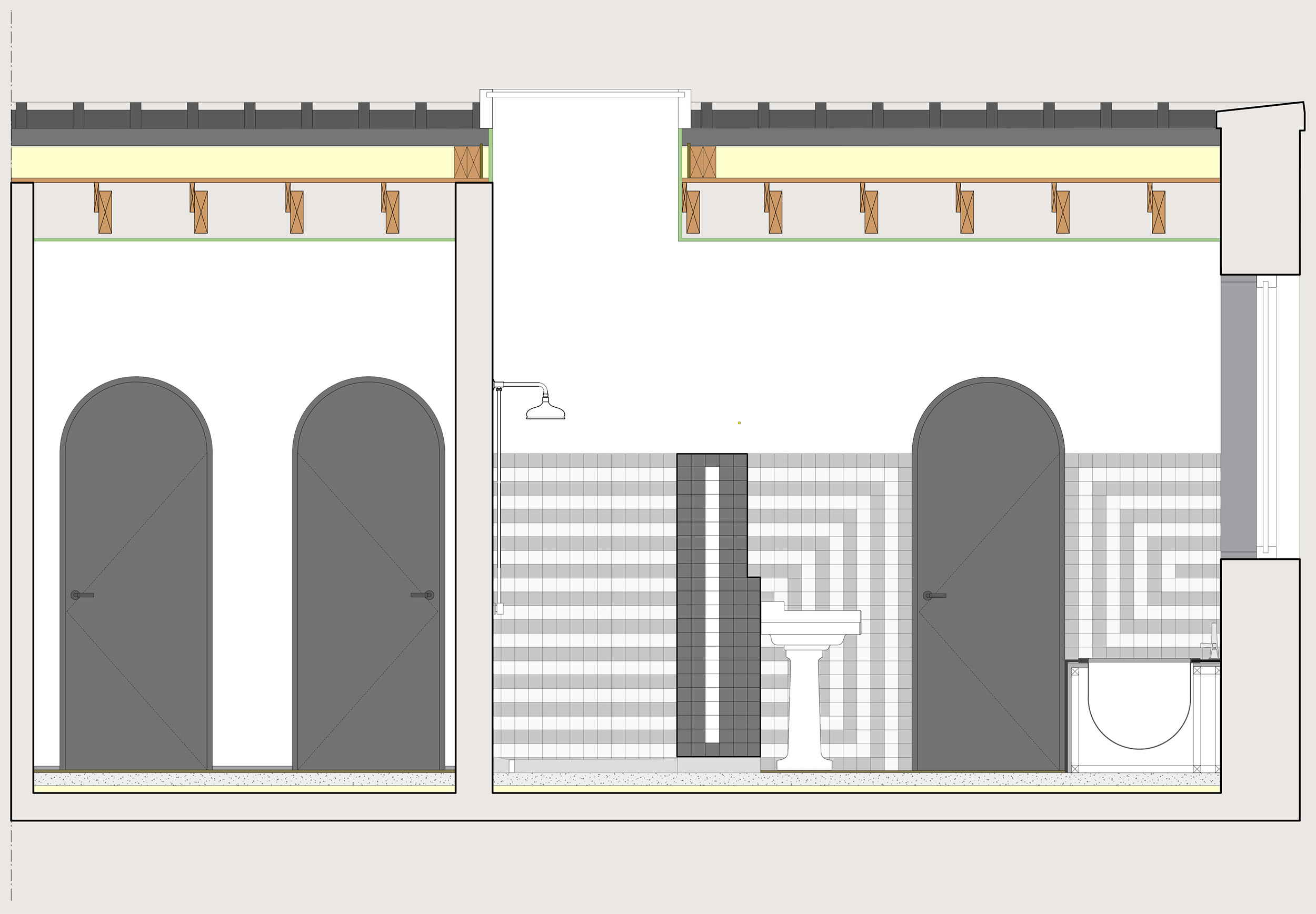
PRIVATE Access to the open-plan residence is through a modest side entrance, where the owner's identity is subtly reflected in the choice of materials. The concrete extension is complemented by handmade Zellige tiles, again nodding to the owner’s Moroccan heritage. The material palette features wooden floors, stainless steel elements, exposed beam ceilings, high-gloss black lacquer, and other rich finishes — brought to life through an eclectic mix of furniture.
PRIVATE Access to the open-plan residence is through a modest side entrance, where the owner's identity is subtly reflected in the choice of materials. The concrete extension is complemented by handmade Zellige tiles, again nodding to the owner’s Moroccan heritage. The material palette features wooden floors, stainless steel elements, exposed beam ceilings, high-gloss black lacquer, and other rich finishes — brought to life through an eclectic mix of furniture.

The kitchen is partially separated by a rounded volume, preserving openness and clear sightlines. Adjacent to the kitchen, a utility room is finished in wood paneling and soft pink Zellige tiles. The stainless steel kitchen unit echoes the concrete in tone but is softened by rounded corners, while the Zellige-clad storage wall doubles as a discreet passage to the utility space.
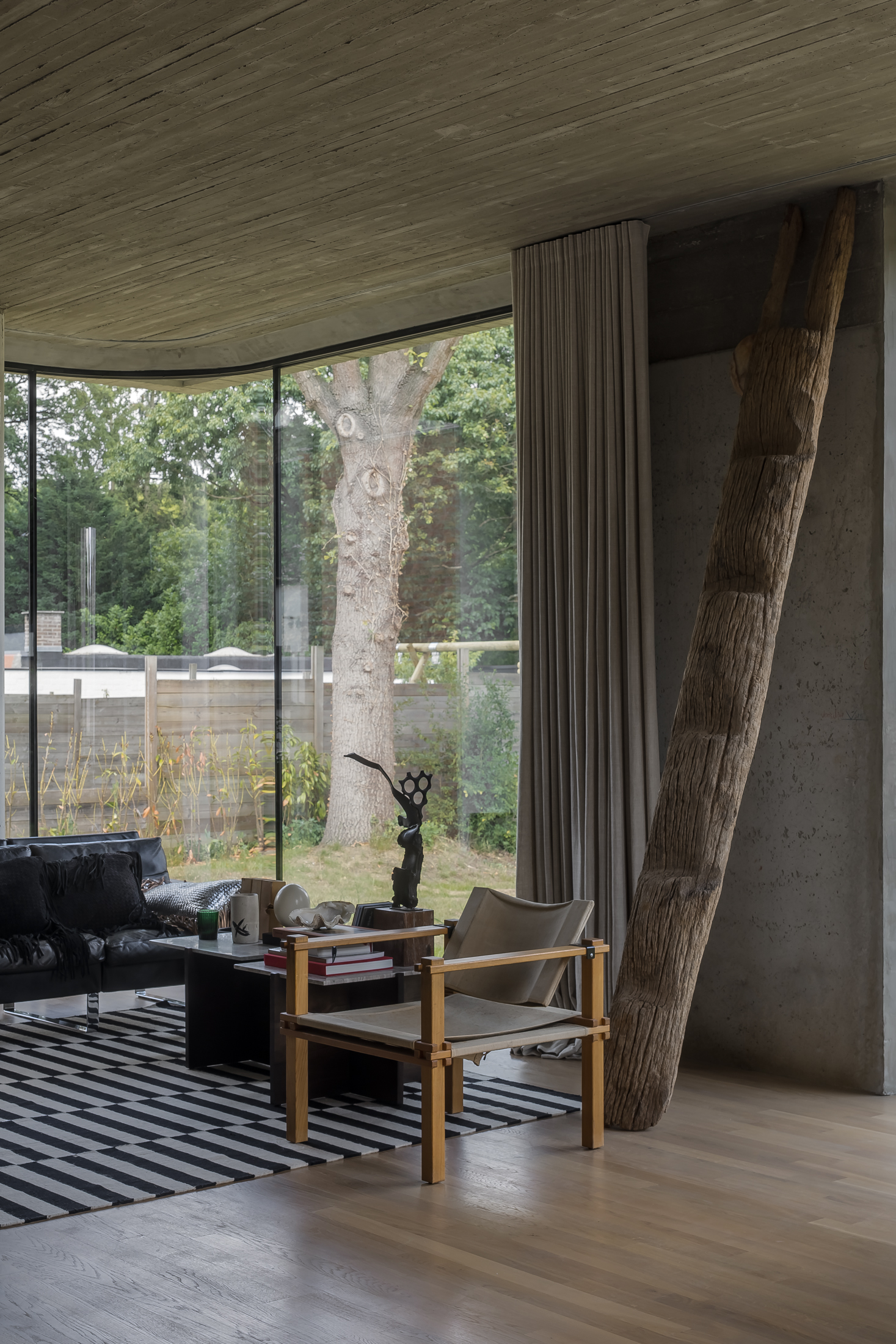














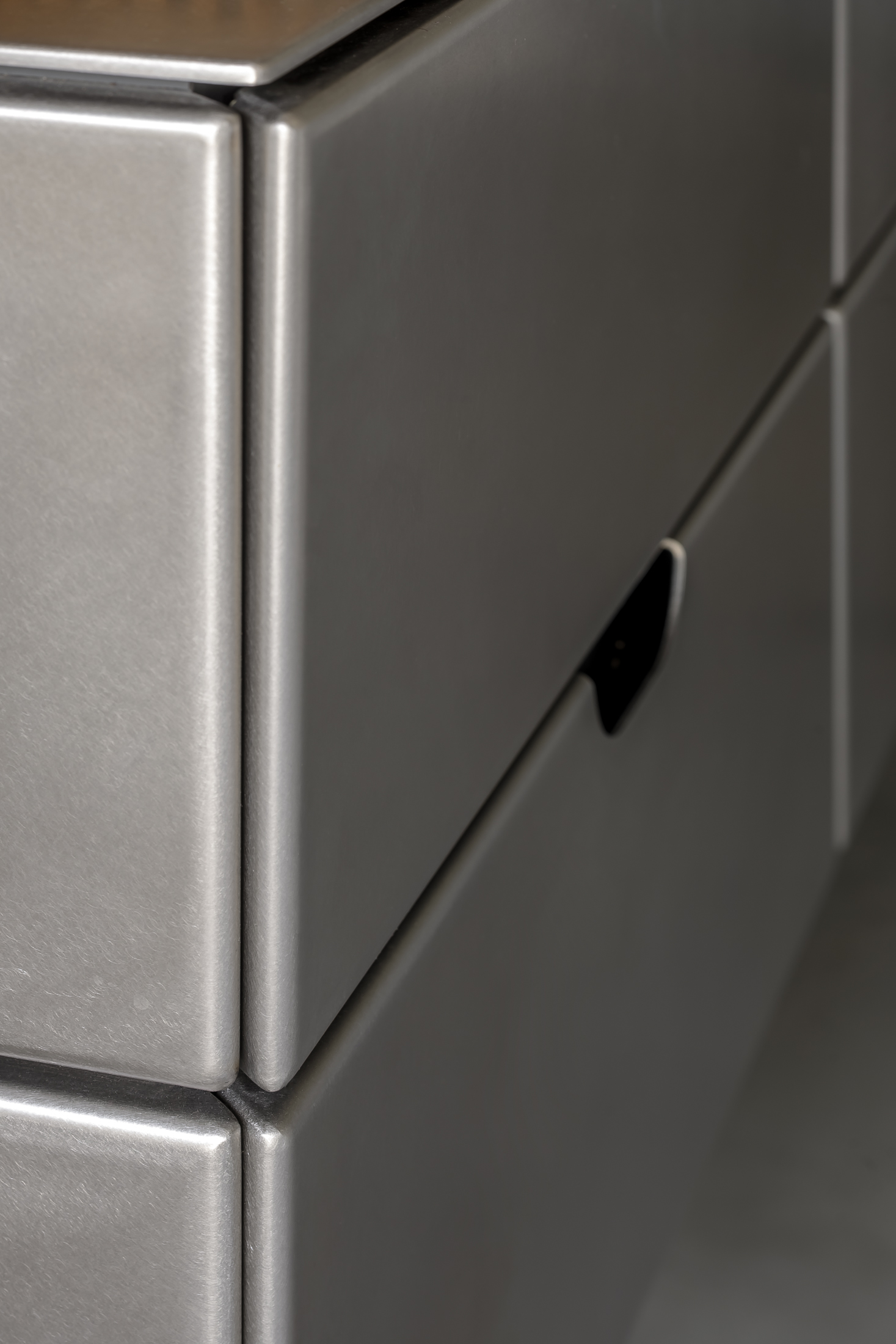

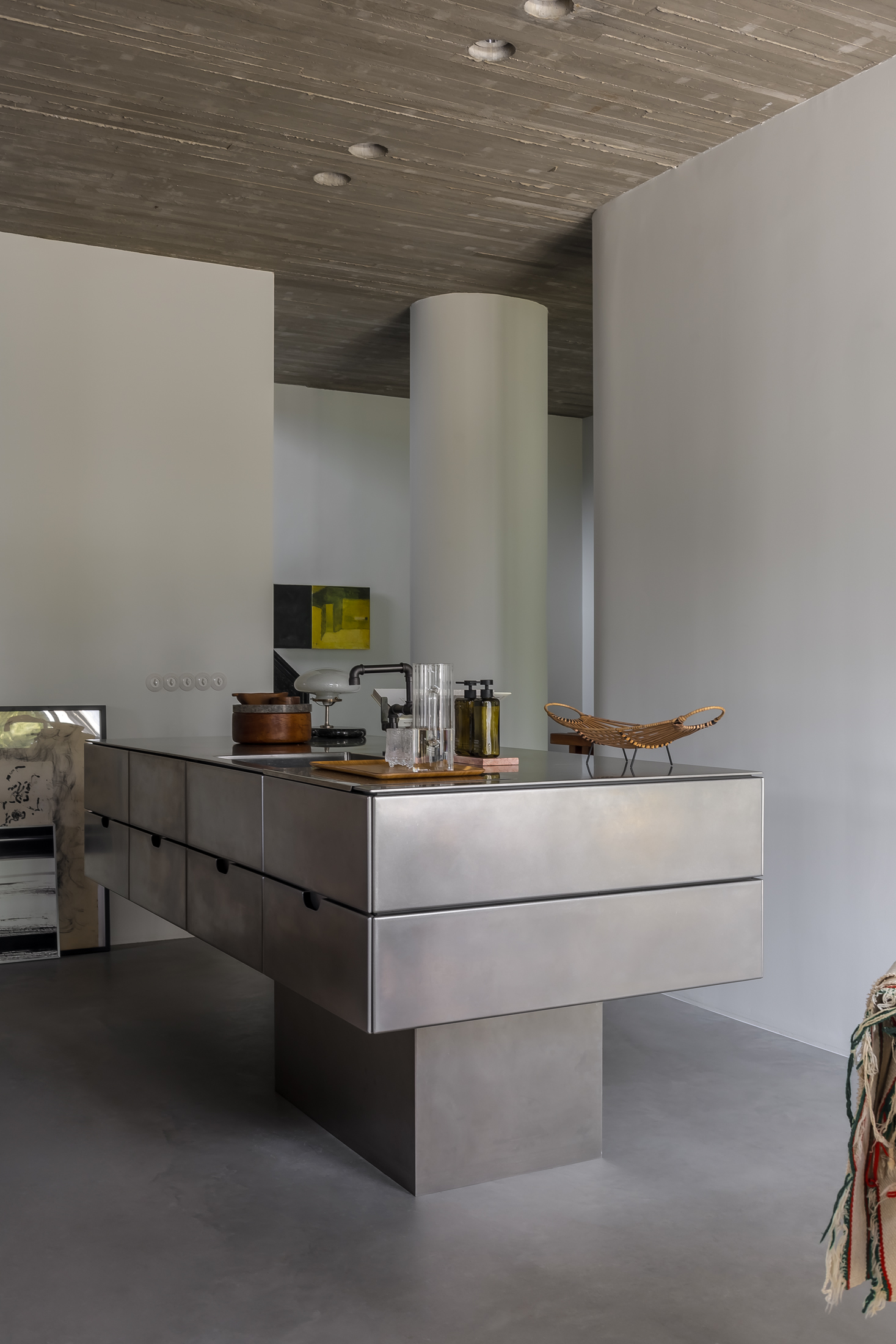






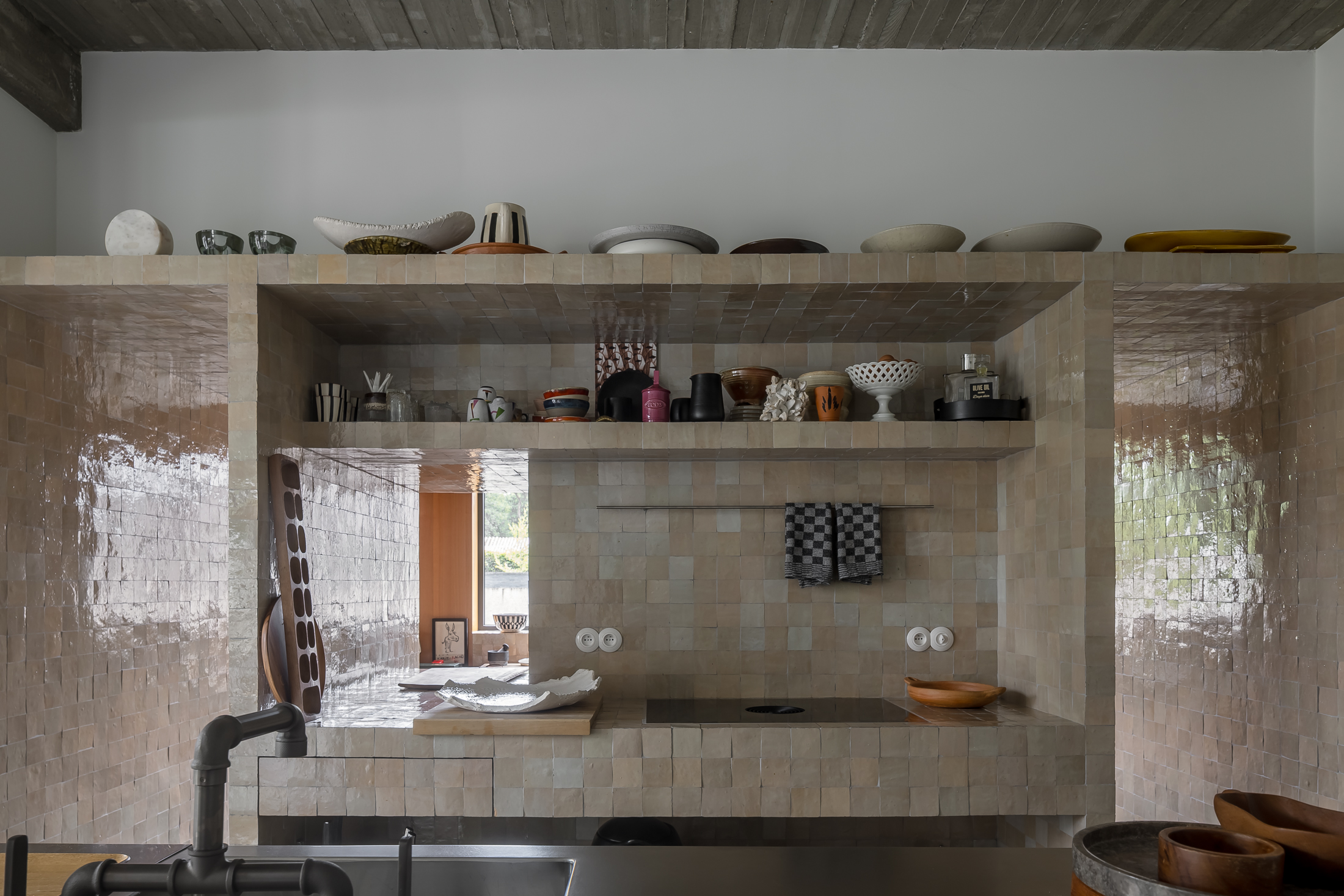





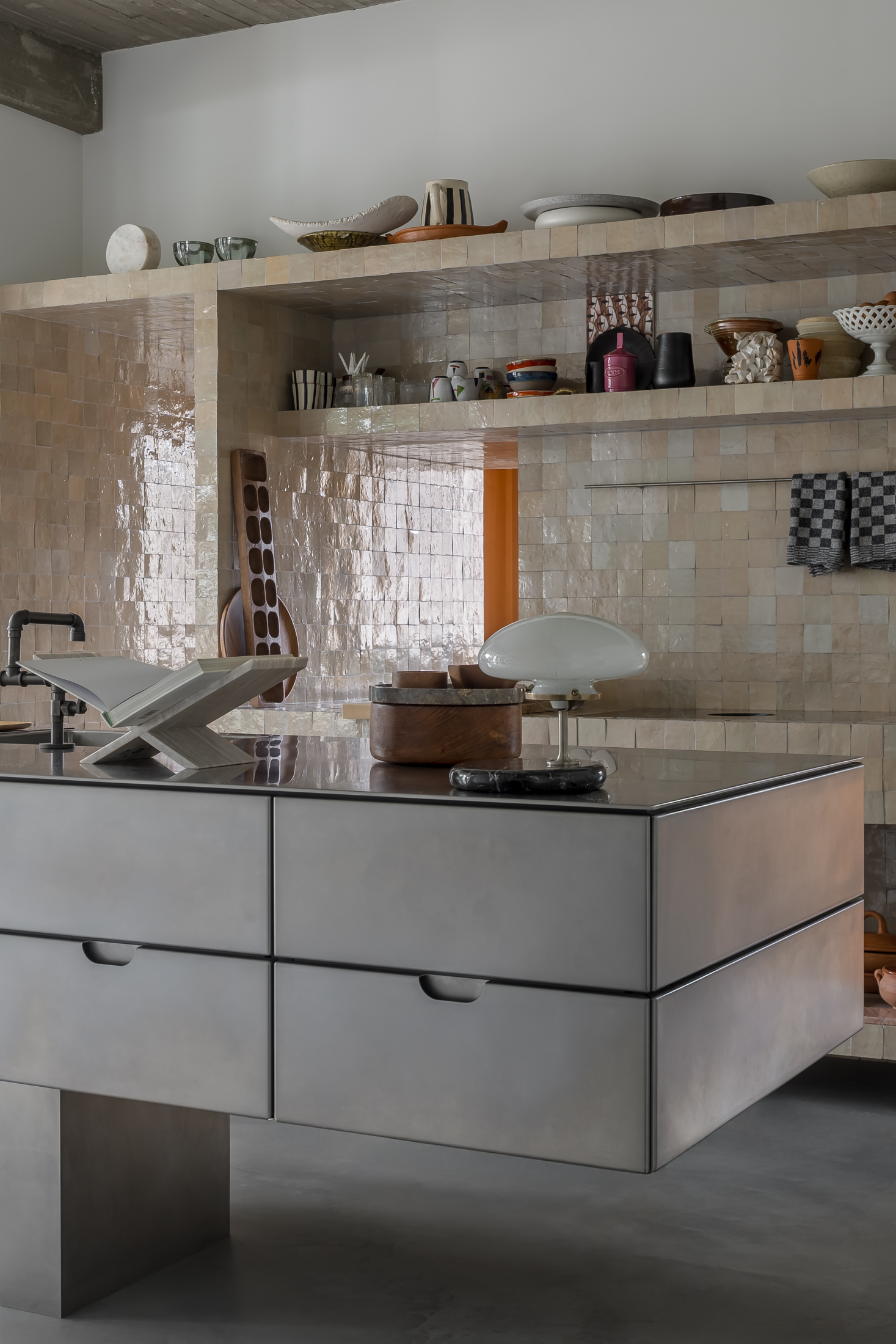








The kitchen is partially separated by a rounded volume, preserving openness and clear sightlines. Adjacent to the kitchen, a utility room is finished in wood paneling and soft pink Zellige tiles. The stainless steel kitchen unit echoes the concrete in tone but is softened by rounded corners, while the Zellige-clad storage wall doubles as a discreet passage to the utility space.
The kitchen is partially separated by a rounded volume, preserving openness and clear sightlines. Adjacent to the kitchen, a utility room is finished in wood paneling and soft pink Zellige tiles. The stainless steel kitchen unit echoes the concrete in tone but is softened by rounded corners, while the Zellige-clad storage wall doubles as a discreet passage to the utility space.

The ground floor offers a spacious dining and living area, softly divided by a floating fireplace volume. This element was integrated during the construction phase, allowing for a seamless alignment with the ceiling and extension. Other distinctive features include a curved window framing the garden and raw concrete walls that enhance the home's tactile quality. A black lacquered staircase leads up to the bed- and bathrooms on the first floor.
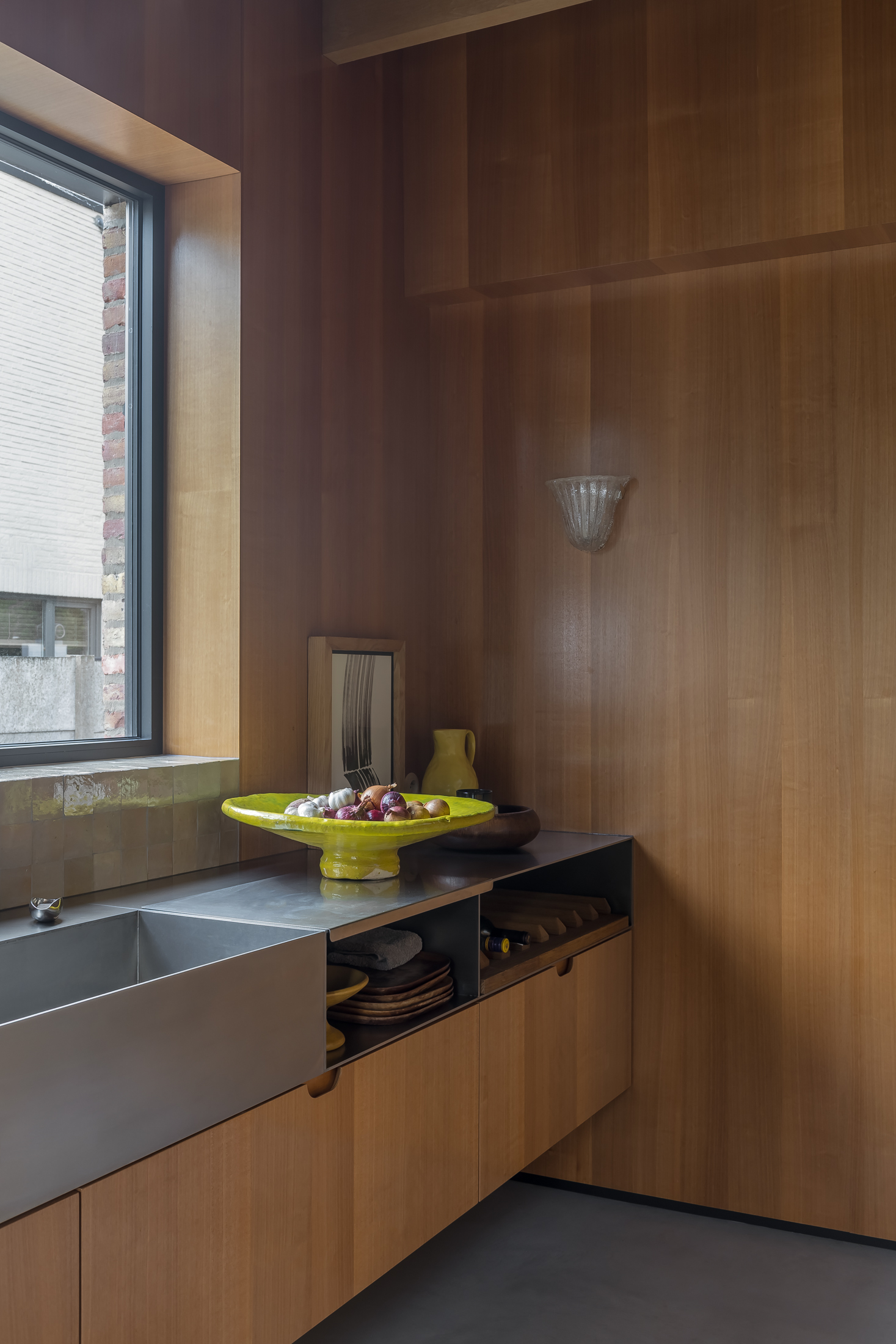

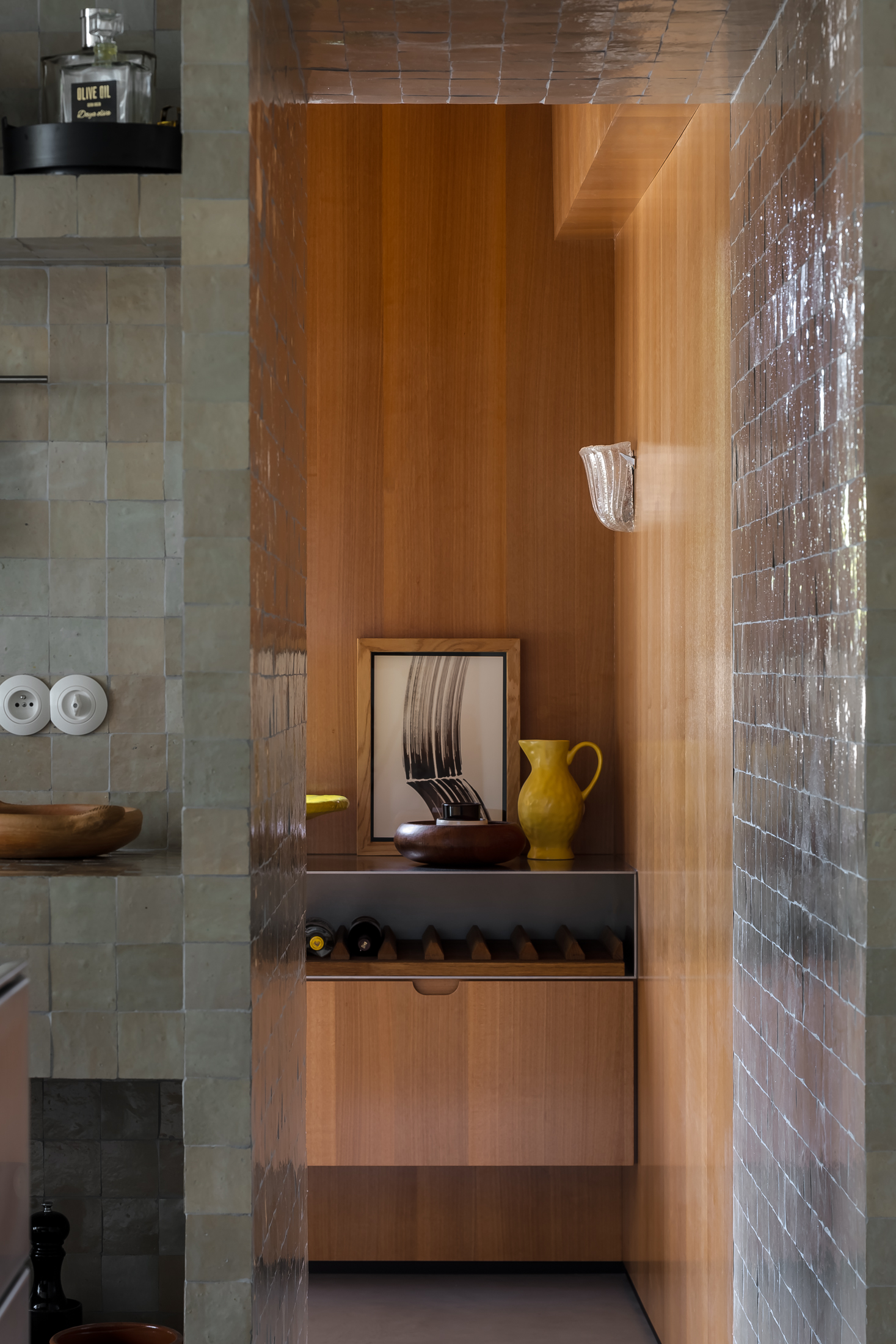












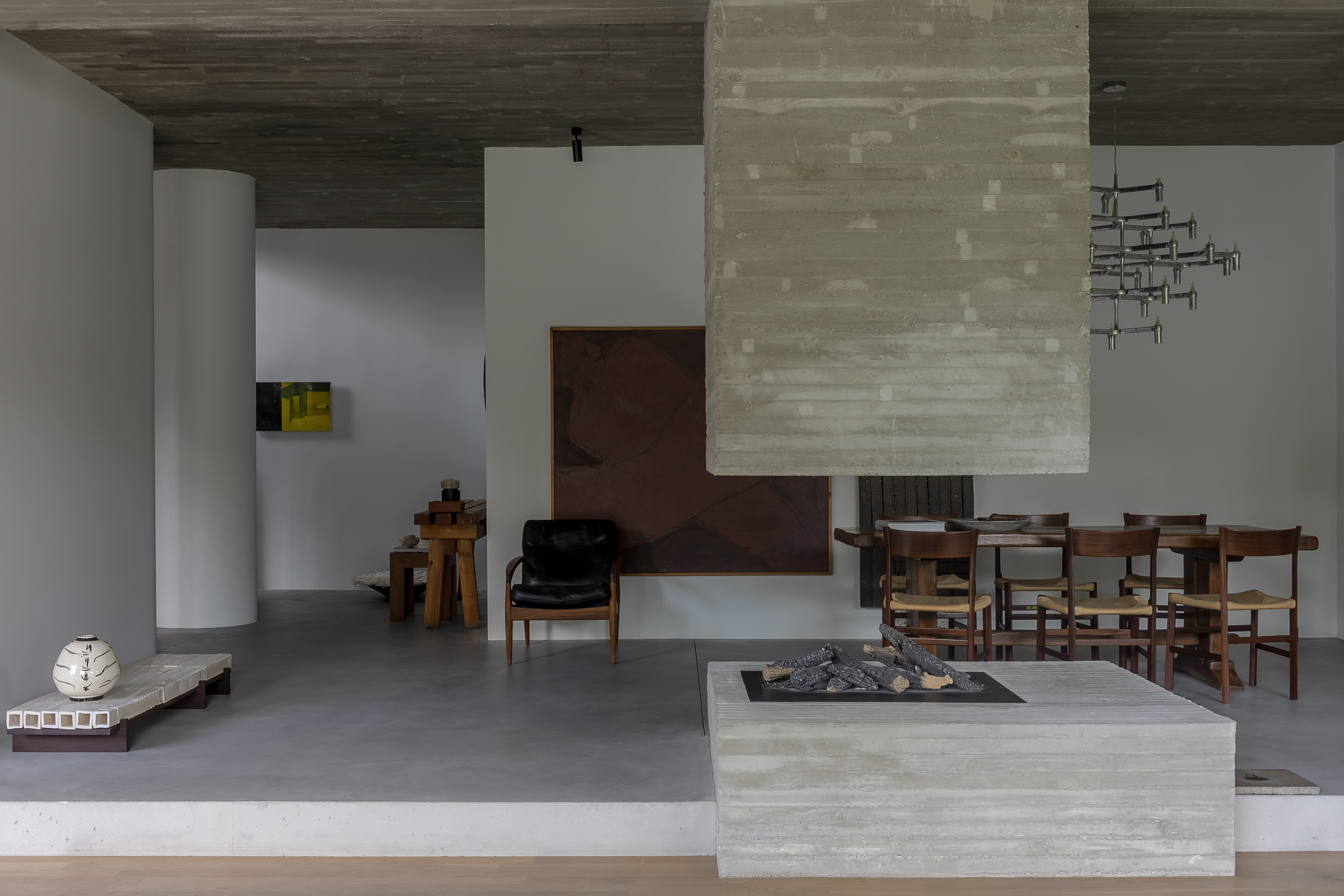







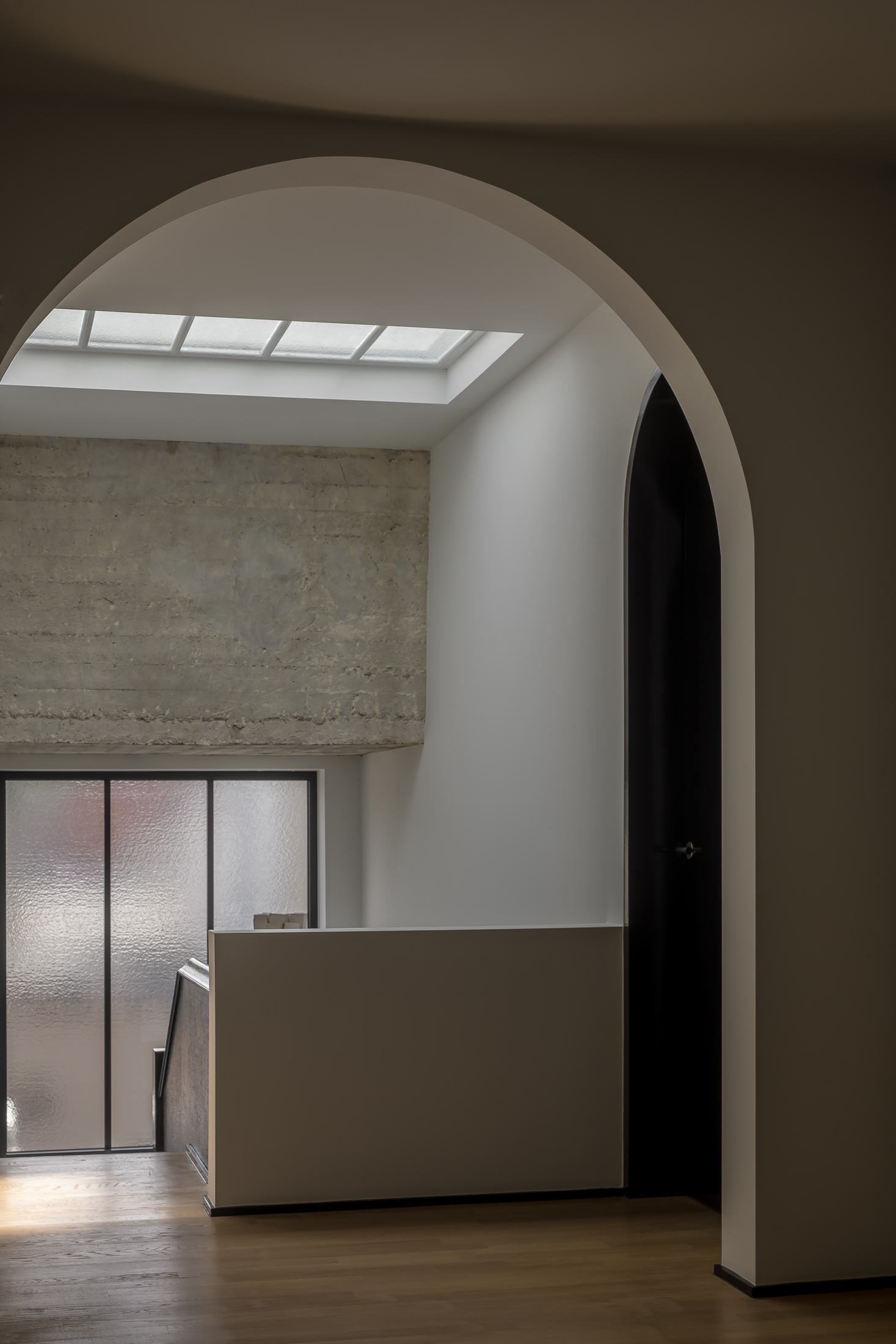






The ground floor offers a spacious dining and living area, softly divided by a floating fireplace volume. This element was integrated during the construction phase, allowing for a seamless alignment with the ceiling and extension. Other distinctive features include a curved window framing the garden and raw concrete walls that enhance the home's tactile quality. A black lacquered staircase leads up to the bed- and bathrooms on the first floor.
The ground floor offers a spacious dining and living area, softly divided by a floating fireplace volume. This element was integrated during the construction phase, allowing for a seamless alignment with the ceiling and extension. Other distinctive features include a curved window framing the garden and raw concrete walls that enhance the home's tactile quality. A black lacquered staircase leads up to the bed- and bathrooms on the first floor.

The bathroom takes cues from the minimalist, geometric work of Sol LeWitt, integrating clean lines and striking contrasts to create a dynamic yet balanced spatial experience. The black-and-white pattern not only elevates the aesthetic but also reflects the relationship between form, structure, and function — a timeless interpretation of modernist principles.
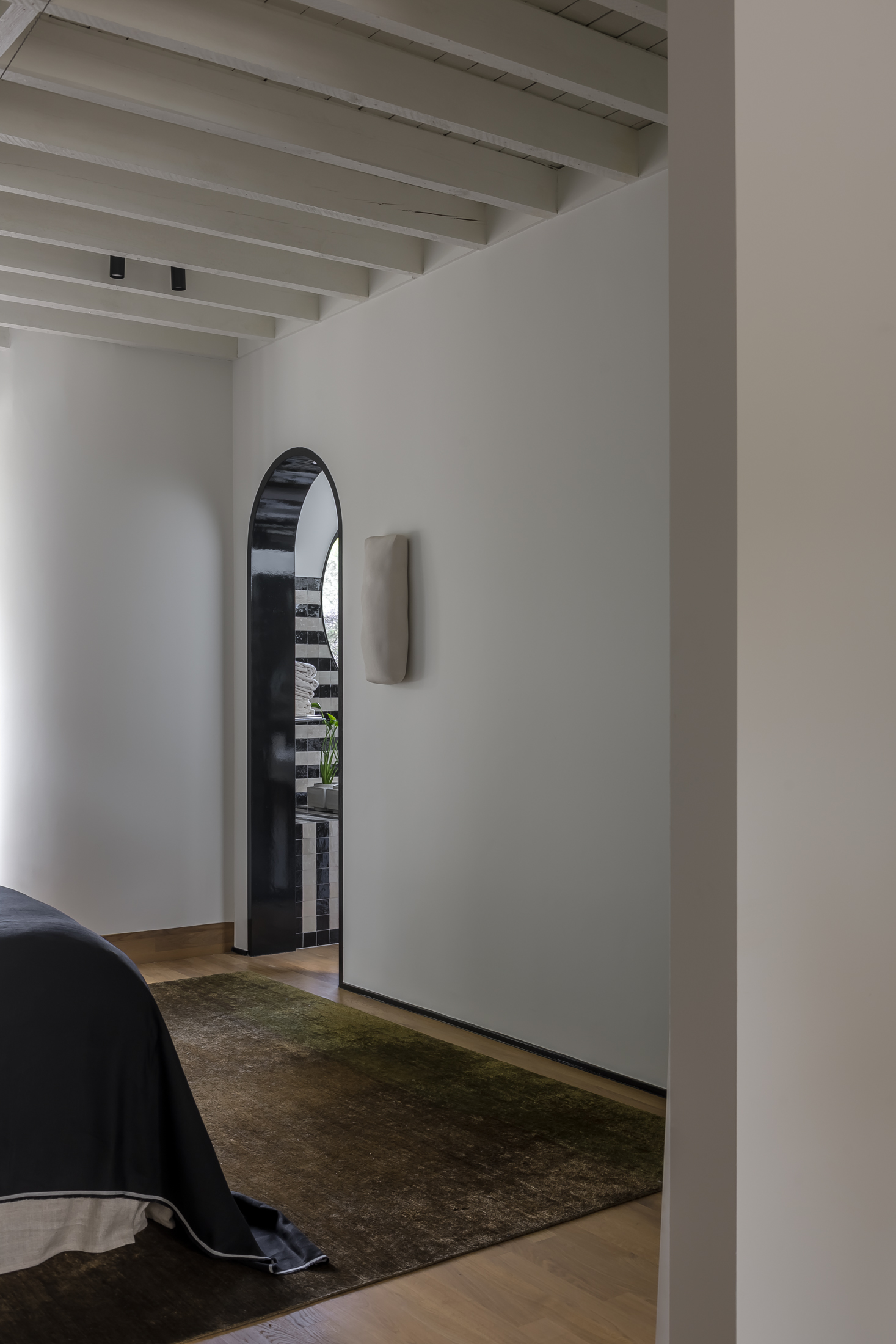





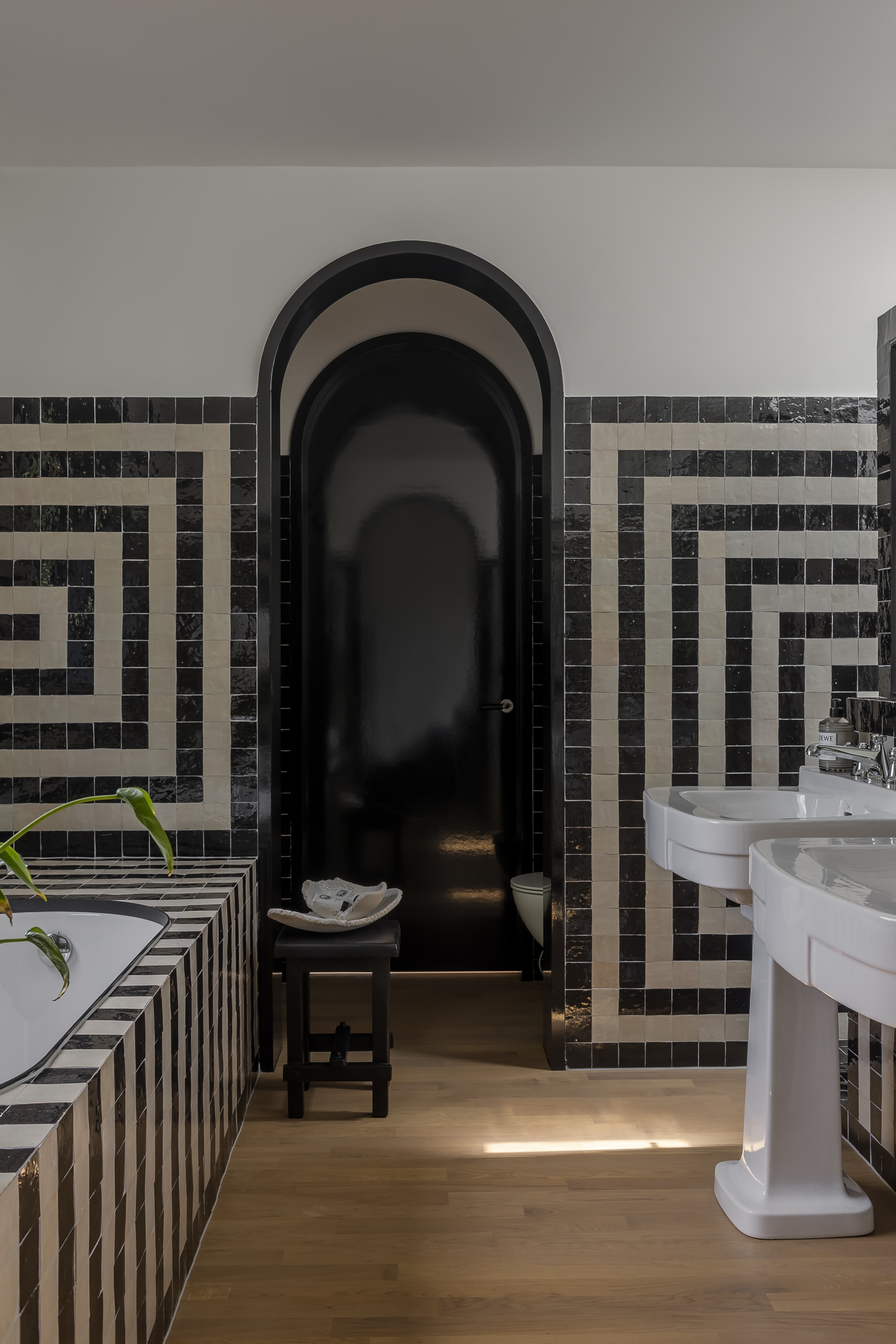

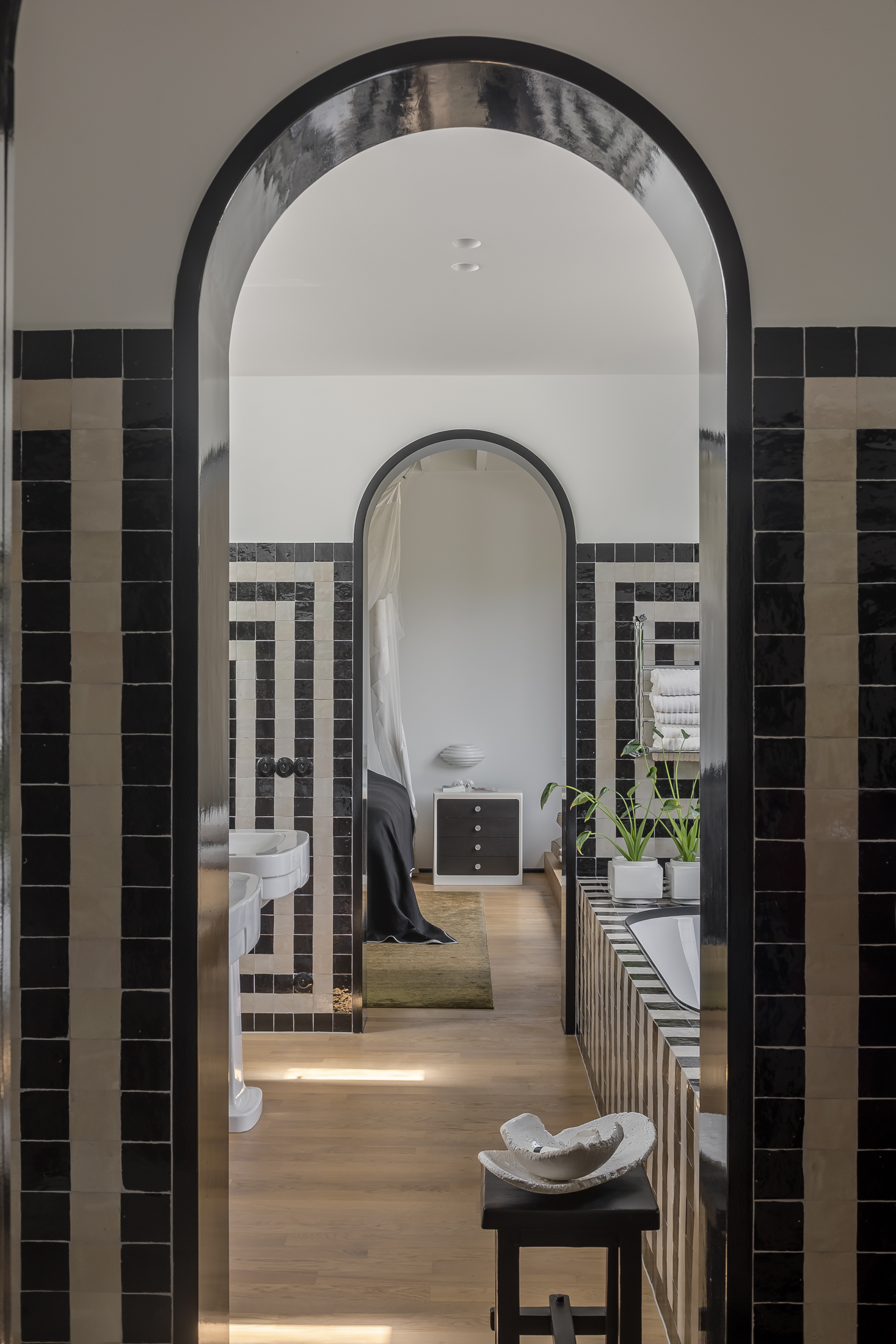






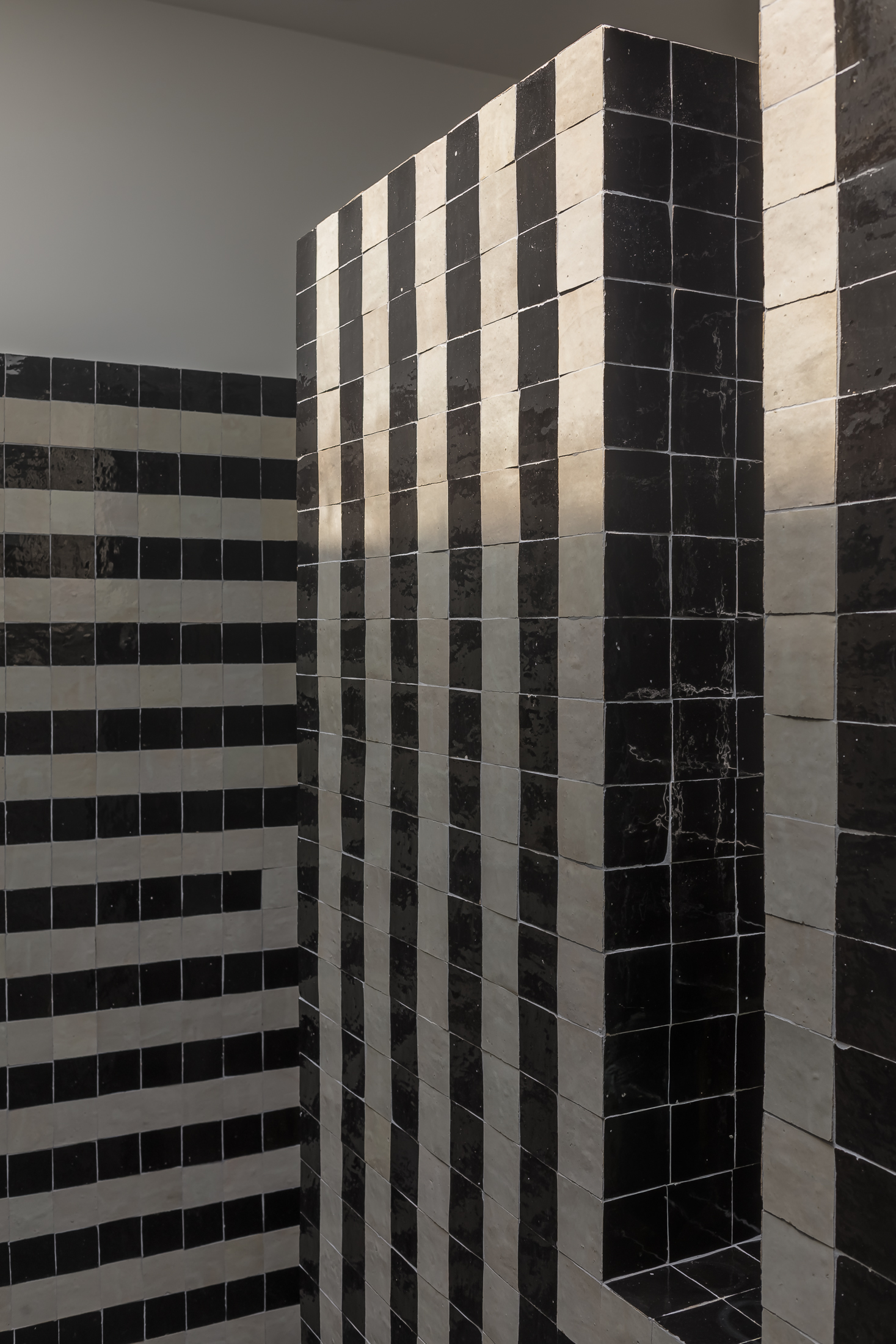








The bathroom takes cues from the minimalist, geometric work of Sol LeWitt, integrating clean lines and striking contrasts to create a dynamic yet balanced spatial experience. The black-and-white pattern not only elevates the aesthetic but also reflects the relationship between form, structure, and function — a timeless interpretation of modernist principles.
The bathroom takes cues from the minimalist, geometric work of Sol LeWitt, integrating clean lines and striking contrasts to create a dynamic yet balanced spatial experience. The black-and-white pattern not only elevates the aesthetic but also reflects the relationship between form, structure, and function — a timeless interpretation of modernist principles.


